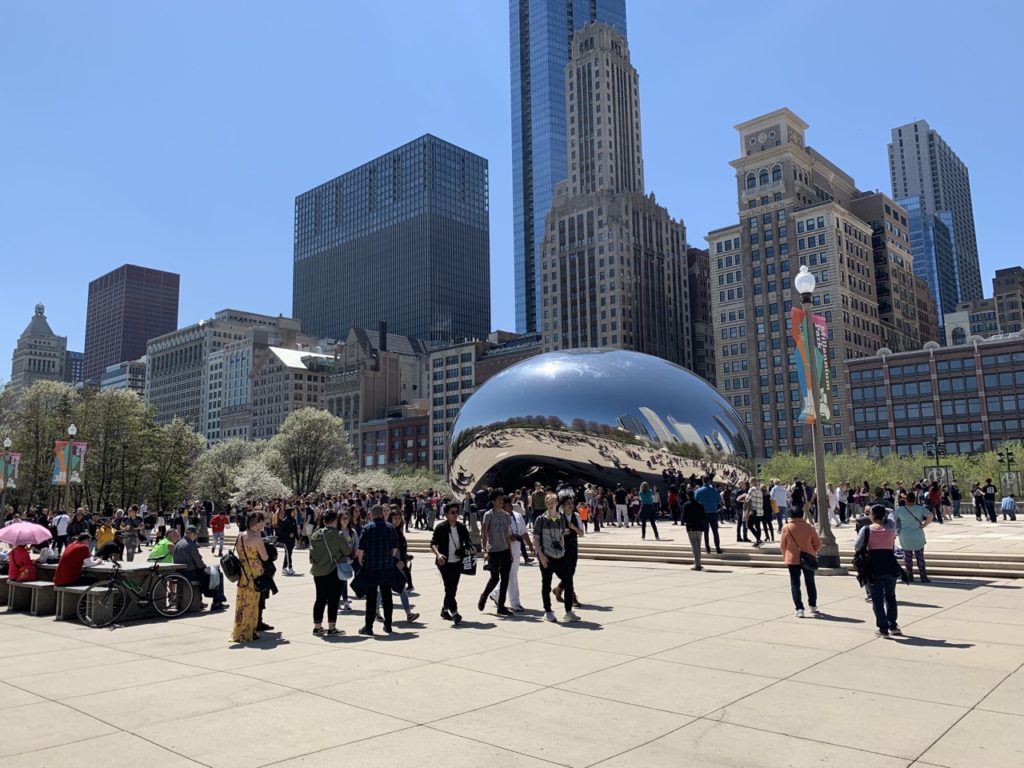Welcome to our Guide to Chicago’s Magnificent Mile—the 0.8 mile section of Michigan Avenue in downtown Chicago famous for its high-end shopping, history, and beautiful views.
Besides just giving the details of the “Mag Mile”—location, major highlights, what’s nearby—we also provide a walking tour that not only covers the shopping highlights, but discusses the important historical buildings and landmarks along the way.
Location and Getting There
Magnificent Mile Highlights
Walking Tour of the Mag Mile
What’s Nearby
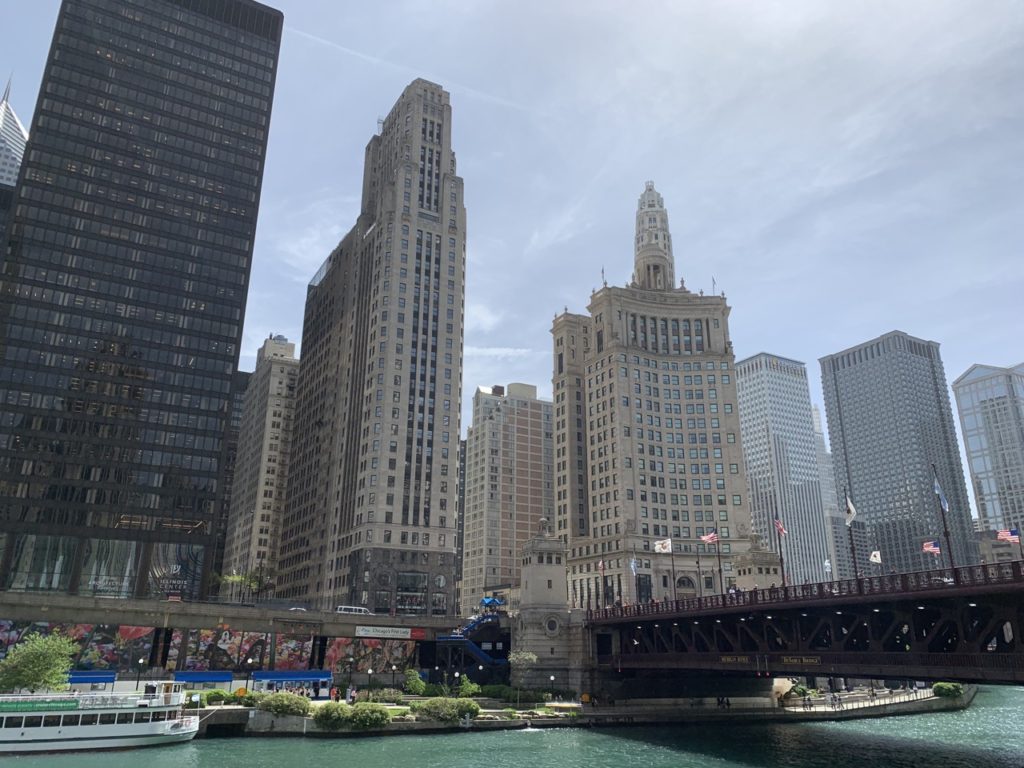
Location and Getting There
The Magnificent Mile (“the Mag Mile”) is 0.8 mile strip of Michigan Avenue in downtown Chicago, between the Chicago River at the south and Oak Street at the north (read more about Chicago’s grid system).
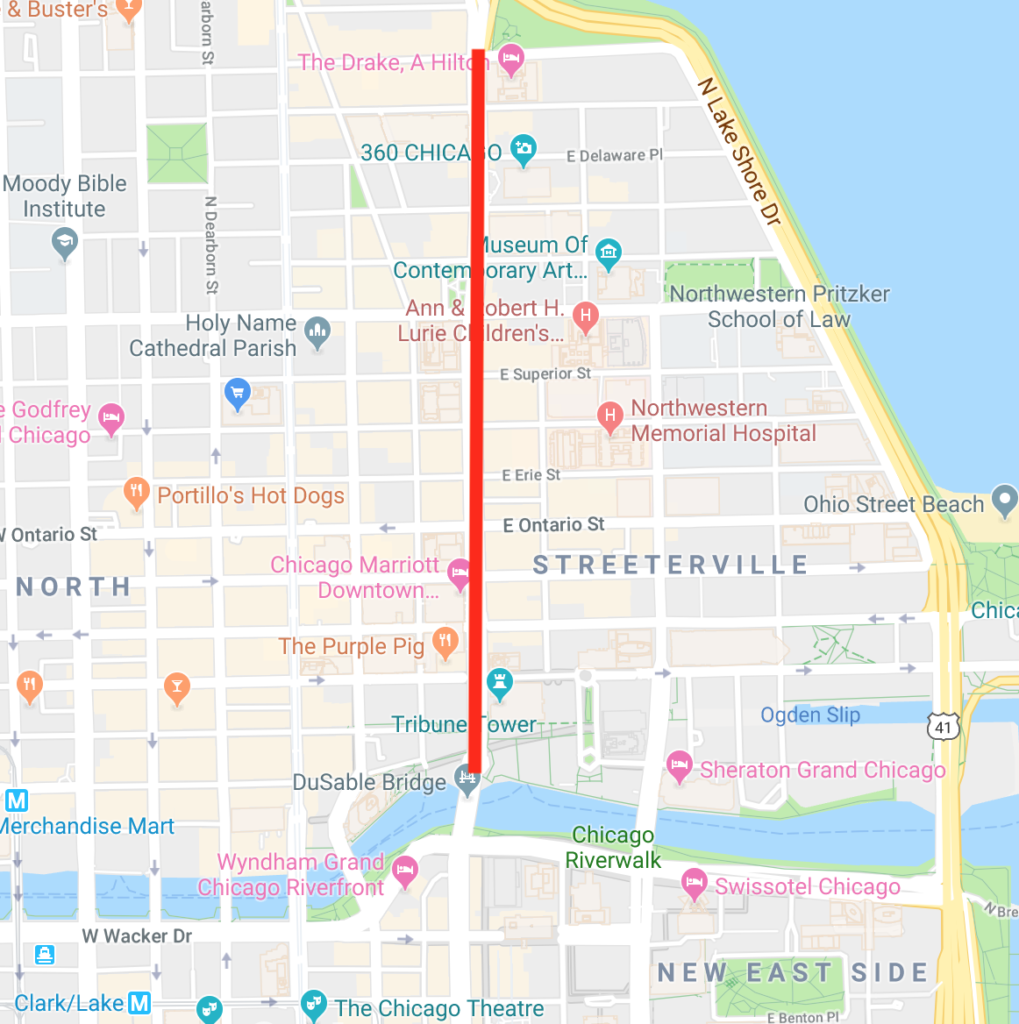
Our walking tour will start at the north end and head south, but if you’re planning to pair this with a visit somewhere else, you may want to change the direction (see “What’s Nearby“).
Driving, Parking, Taxis, and Uber
There are plenty of garages and limited street parking near the Mag Mile. Expect to pay $20 to $40 for a full day visit. If taking a taxi or Uber, use The Drake Hotel as your destination to start at the north end or Tribune Tower to start at the south end.
Getting to the Mag Mile via the L
Coming from outside downtown, the quickest way to get to the Mag Mile will typically be by train.
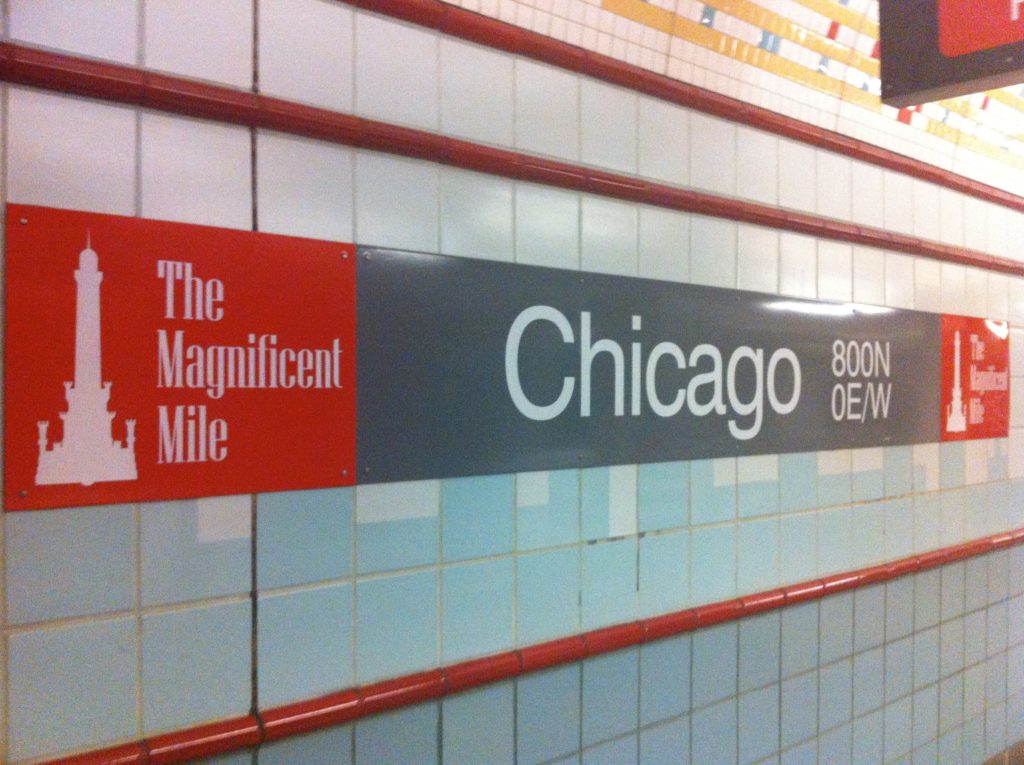
If you’re taking Chicago L train system, you can use the following stops for easy access to the Mag Mile (directions just indicate which end of the Mag Mile you’ll be nearest):
- Red Line — Chicago (north end of Mag Mile); Grand (south)
- Brown & Purple Lines — Merchandise Mart (south)
- Yellow Line — Switch to Red Line at Howard
- Other Lines — Clark / Lake (south)
Taking the Metra to the Mag Mile
The southern end of the Mag Mile is just between 1 and 1.5 miles from Ogilvie Transportation Center and Union Station. We recommend walking to Lake and the Chicago River, at which point you can follow the Riverwalk along the southern edge of the river to Michigan. Alternatively, a variety of CTA buses connect the train stations to Michigan Avenue.
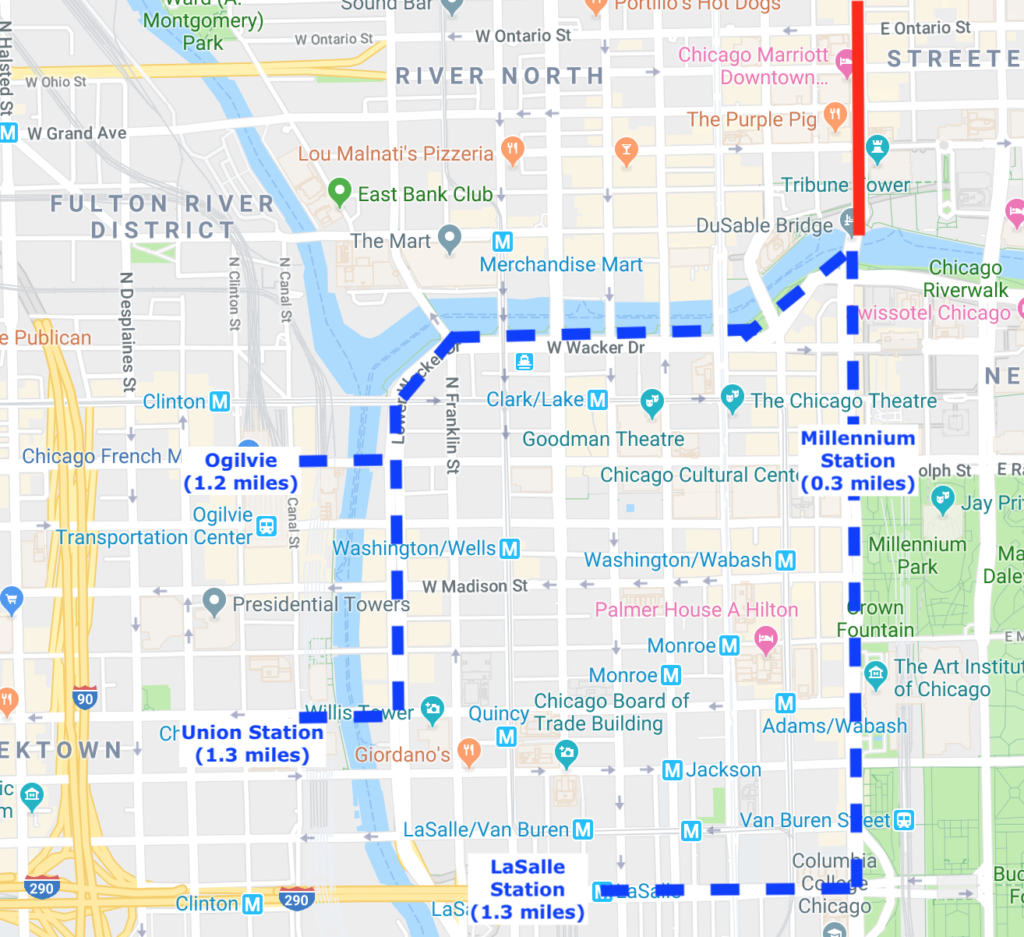
Millennium Station is less than a half-mile straight south of the southern end of the Mag Mile, on Michigan Avenue. LaSalle Street Station is over a mile south. We recommend taking a bus or walking east to Michigan and then north, possibly visiting Millennium Park and Maggie Daley Park along the way.
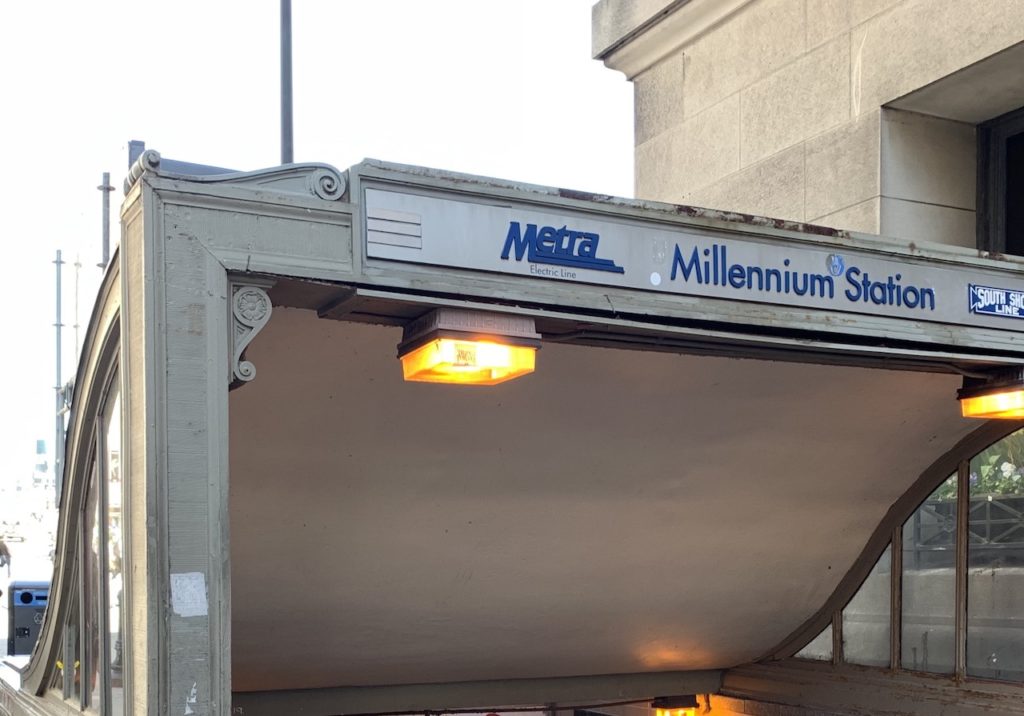
If you come from the Metra, you’ll need to reverse the order of our walking tour.
Taking the CTA Bus to the Mag Mile
There are a huge number of buses that stop directly at the Mag Mile or nearby. We have a guide to taking the CTA bus system in Chicago.
We recommend using Google Maps to find bus directions. Use The Drake Hotel as your destination to start at the north end and Tribune Tower to start at the south end.
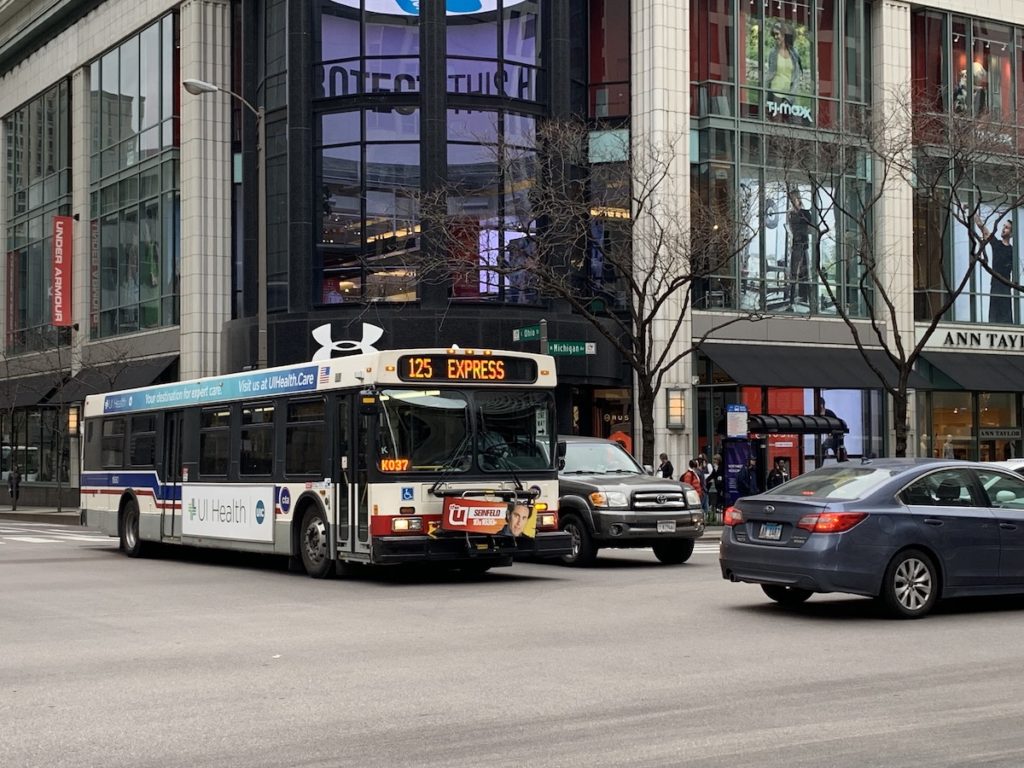
Magnificent Mile Highlights
While we don’t want to provide a list of every store, restaurant, landmark, etc. along the Mag Mile, we do want to give you an idea of the highlights. If you’re looking for a more detailed walking tour, just keep reading past the lists or click to jump to the tour!
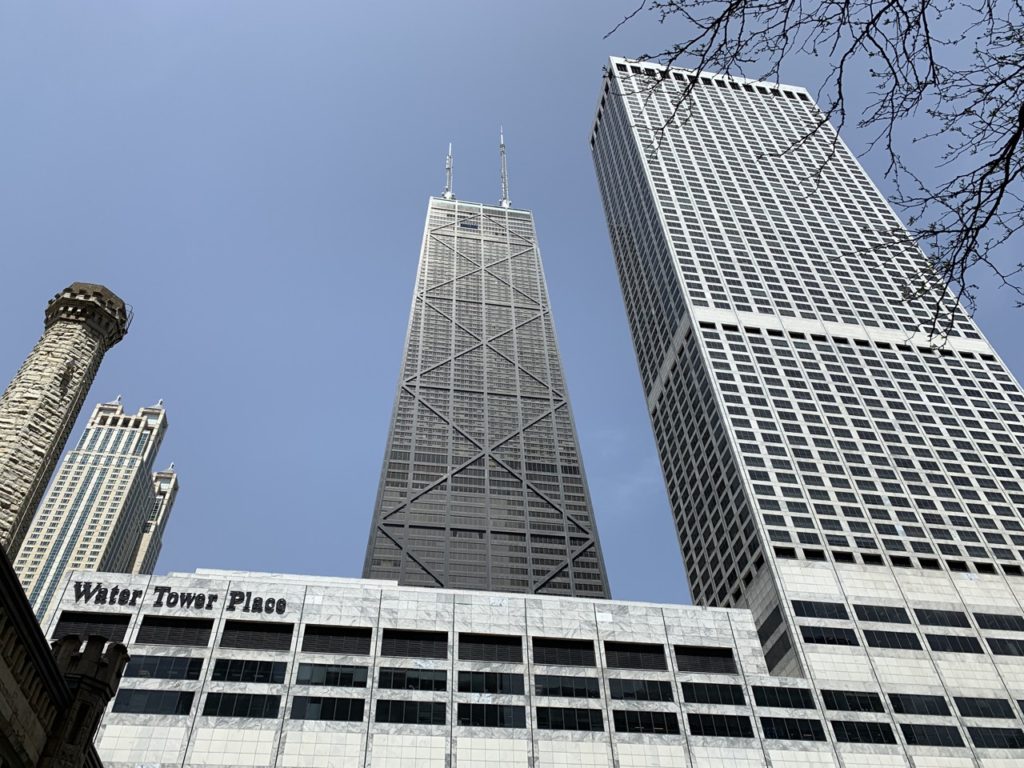
Keep in mind, by the way, that this list is confined to the Mag Mile and its immediate vicinity. Not only does it not list every spot on the Mag Mile, but it doesn’t list any in the adjacent neighborhoods. If you’re looking from dining and nightlife, for example, you’ll find a ton a block west in River North.
Shopping
- Oak Street (luxury shopping street) (1000 North)
- 900 North Michigan (mall anchored by Bloomingdale’s)
- Louis Vuitton (919 N Michigan)
- Water Tower Place (835 N Michigan) (mall anchored by Macy’s)
- Neiman Marcus (737 N Michigan)
- Tiffany & Co. (730 N Michigan)
- Nike (669 N Michigan)
- Burberry (633 N Michigan)
- Shops at North Bridge (520 N Michigan) (mall anchored by Nordstrom)
- Apple (401 N Michigan)
Restaurants
- The Signature Room at the 95th (875 N Michigan)
- Gino’s East (162 E Superior)
- Grand Lux Cafe (600 N Michigan)
- The Purple Pig (444 N Michigan)
- Billy Goat Tavern (430 N Lower Michigan) (recommended)
Hotels
- The Drake (140 E Walton)
- Four Seasons Chicago (120 E Delaware)
- Ritz-Carlton Chicago (160 E Pearson)
- InterContinental (505 N Michigan)
Landmarks
- Palmolive Building
- Fourth Presbyterian Church
- John Hancock Center
- Water Tower & Pumping Station
- Allerton Hotel
- Jean Baptiste Point du Sable Homesite
- Michigan-Wacker Historic District
Walking Tour of Michigan Avenue
This walking tour is going to cover shopping and landmarks. Landmarks obviously get more explanation, but if you’re not into history then you might not care to learn about them.
By contrast, shopping destinations are self-explanatory (or at least I’m not going to go out of my way to explain to you what Nordstrom sells), but for some of you they might be the real highlight.

Getting Your Bearings
As we’re Chicagoans, we use the terms “north,” “east,” “south,” and “west” frequently. We’re starting at the north end of Lake Shore Drive, at Oak Street. Heading south, the east side of the street will be on your left and the west side on your right.
If you’re unsure of the direction you’re heading, besides using traditional navigation methods like the position of the sun, you can look at the addresses on Michigan. On the Mag Mile, they’ll increase as you head north and decrease as you head south.
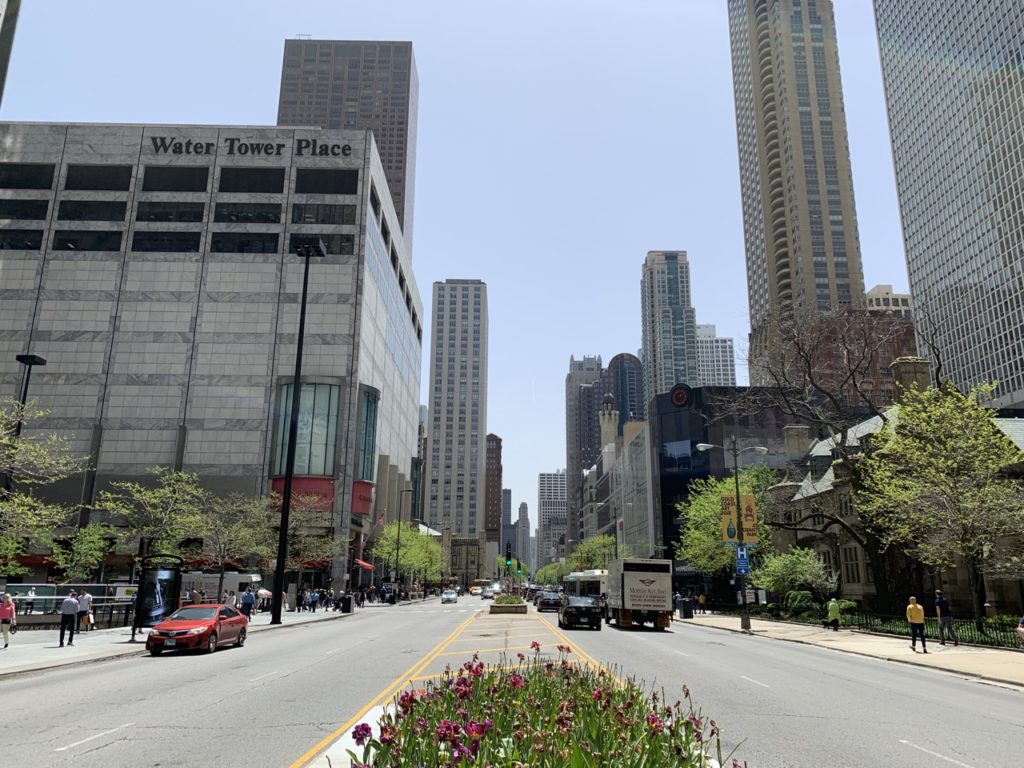
Oak Street and Oak Street Beach
These two are not technically part of the Magnificent Mile, but it would be silly to ignore Oak Street and Oak Street beach while starting right here.
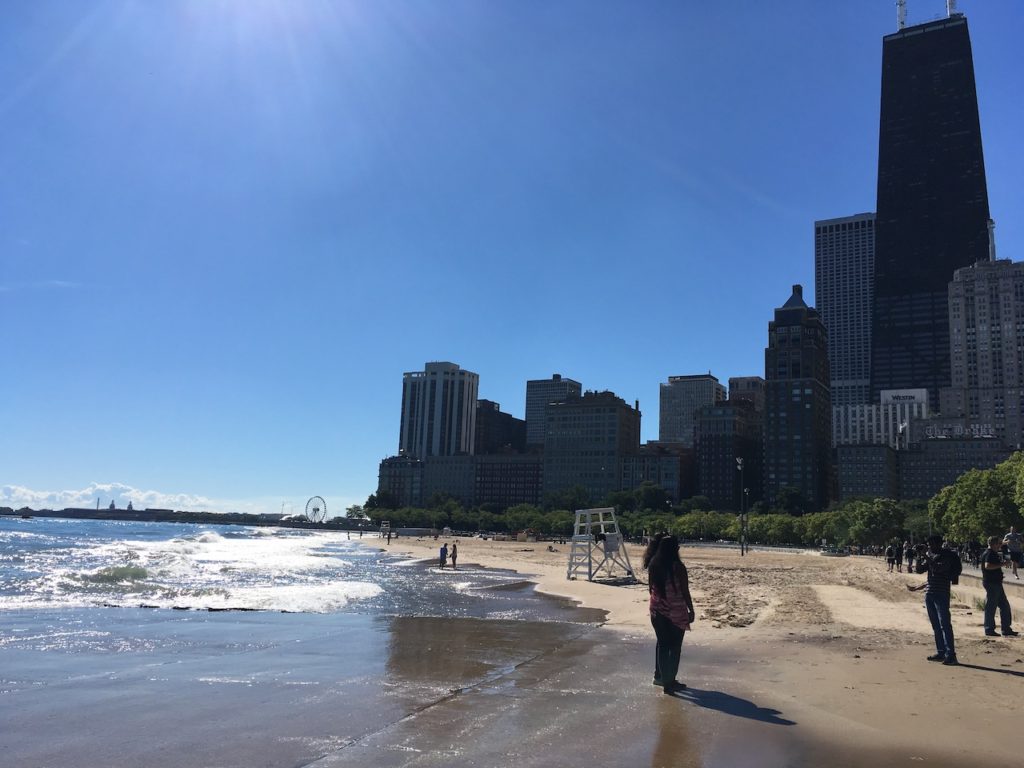
Oak Street Beach is one of the city’s more prominent beaches and is part of a long collection of beaches along Lake Michigan. The beach sits on the Lakefront Trail, an 18-mile long multi-use trail along Lake Michigan.
You can access Oak Street Beach from Michigan Avenue and Oak Street via an underpass.
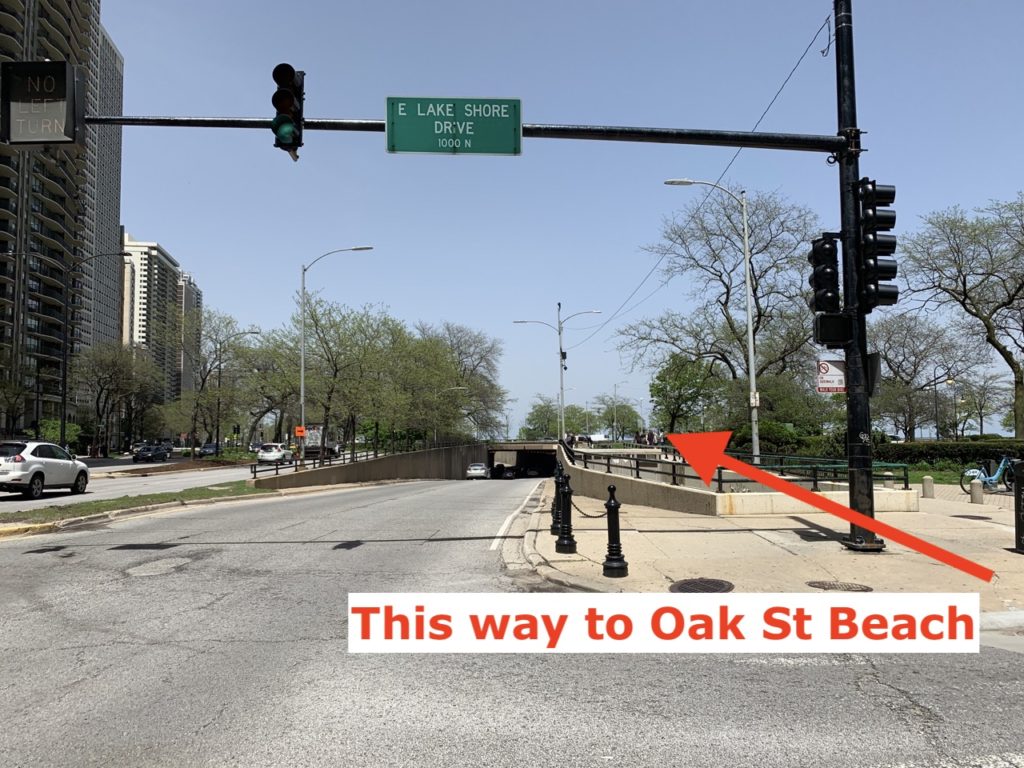
If you’re here for shopping (or if you just want to feel fancy), add the 0.2-mile strip of Oak Street west of Michigan Avenue to make your trip a full mile (the Mag Mile is only 0.8 miles).
Oak Street is actually the highest end strip of shopping in the city, with Hermes, Harry Winston, Tory Burch, Christian Louboutin, Graff, and more. It’s also just a charming stroll.
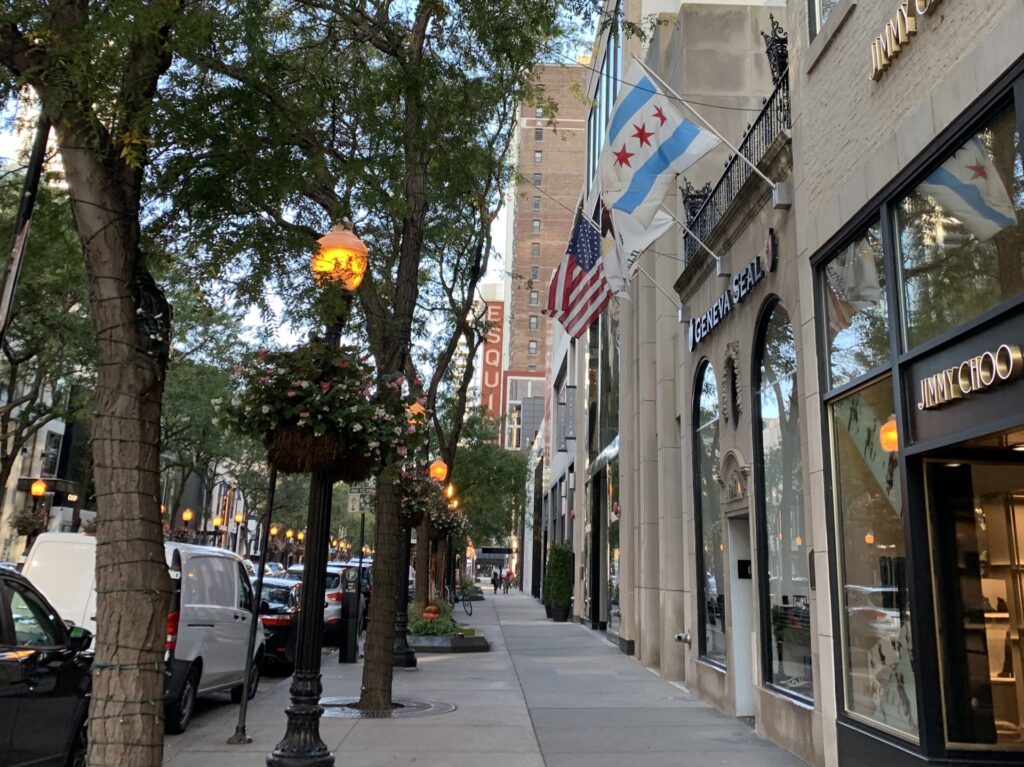
The Drake Hotel
The Drake Hotel is one of the most famous hotels in Chicago. Founded in 1920 by the Drake brothers, the hotel is positioned particularly prominently when viewed from Lake Shore Drive or Oak Street Beach.
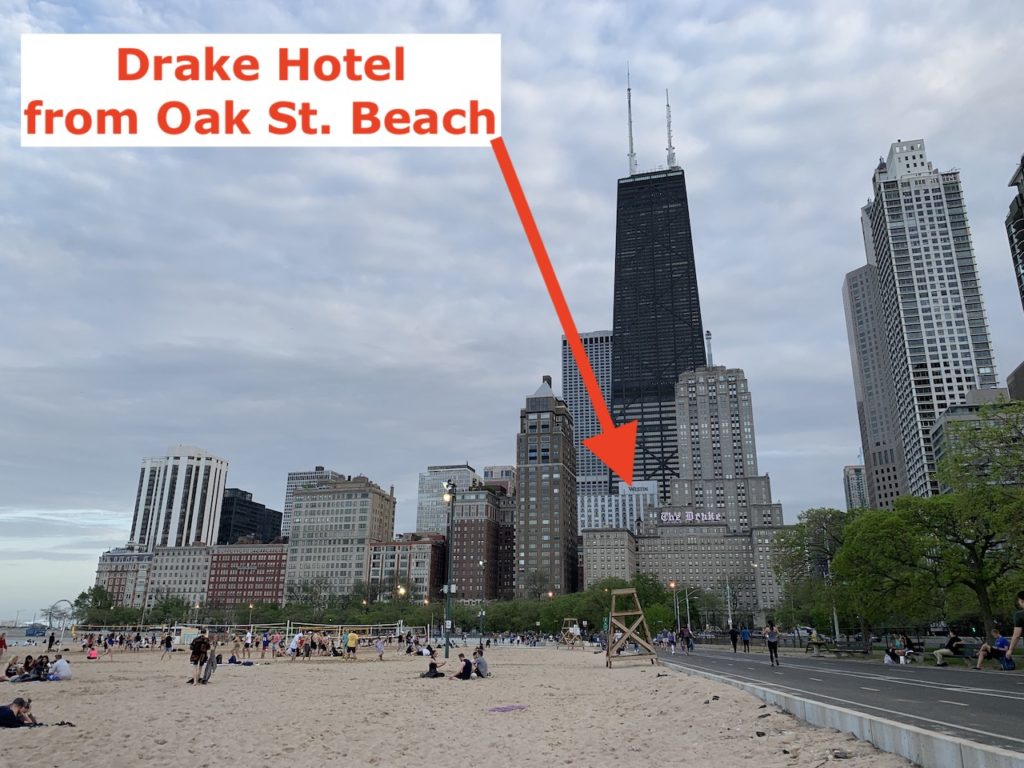
The hotel historically hosted a wide range of celebrities, politicians, and royalty, including Queen Elizabeth, Princess Diana, Marilyn Monroe, Joe DiMaggio, and Walt Disney.

The Drake offers a famous afternoon tea service. Chicago Magazine chronicles some creepy stories of the hotel. Chanel and Van Cleef & Arpels comprise the hotel’s retail space along Michigan Avenue.
Palmolive Building
The Palmolive Building, completed 1929, is just south of The Drake Hotel. Besides being an early skyscraper in the area, the Art Deco building is most widely known for two things.

First, from 1965 to 1989 the building housed the Playboy offices and featured a prominent PLAYBOY sign. Second, on top of the building is the Lindbergh Beacon, named after Charles Lindbergh.
900 North Michigan & Louis Vuitton
900 North Michigan, on the west side of Michigan, is the first mall we encounter. The mall is anchored by Bloomingdale’s and is also home to the Four Seasons Chicago. Other prominent stores include Gucci, Kate Spade New York, and Kendra Scott.
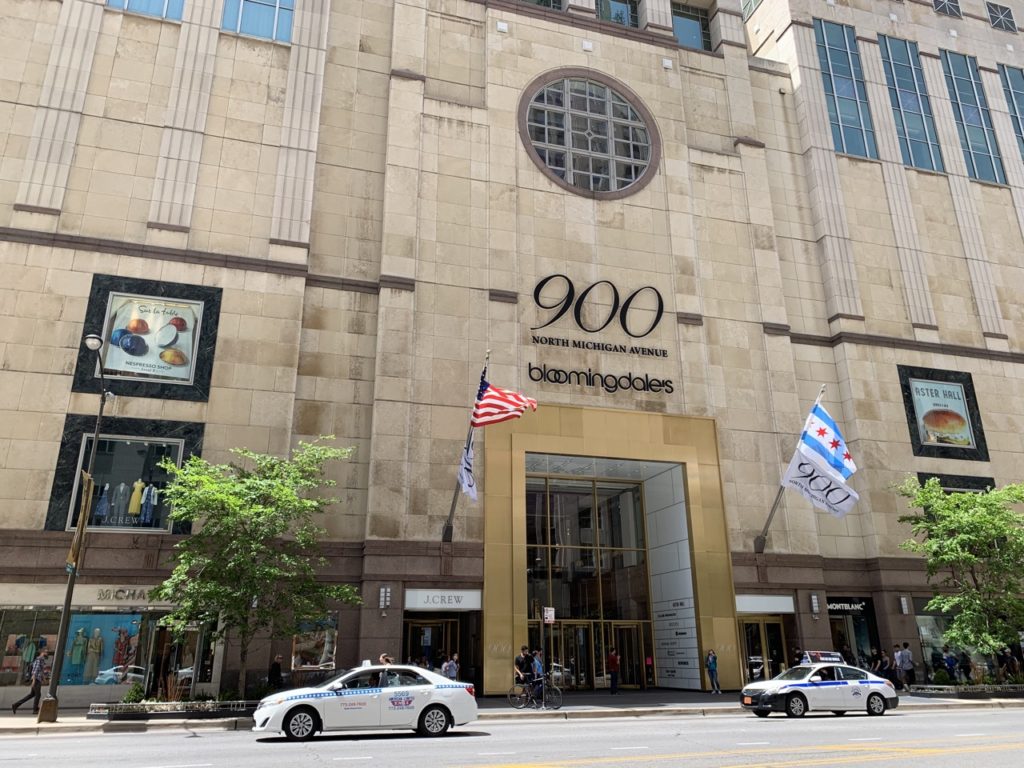
Across Michigan is the Louis Vuitton store.
Fourth Presbyterian Church
On the west side of Michigan, between Delaware and Chestnut, across from the John Hancock Center, is Fourth Presbyterian Church.
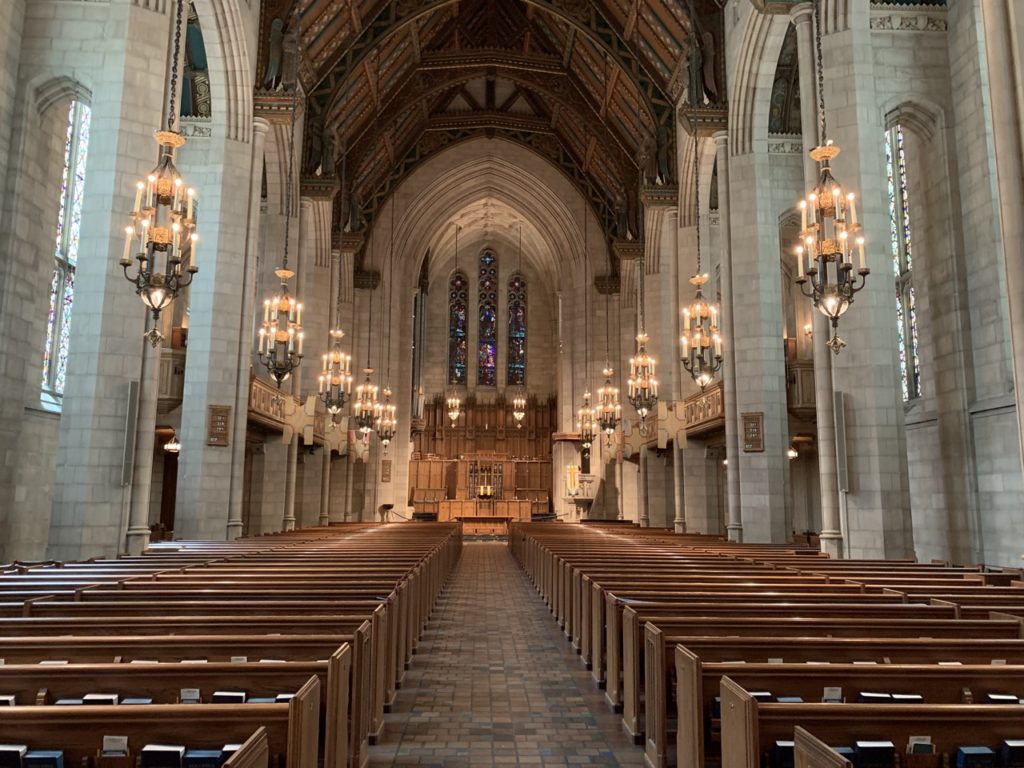
Built between 1912 and 1914, the church is the second oldest building on the Mag Mile. The sanctuary is open to the public from 8AM to 6PM.
John Hancock Center
Technically now just “875 North Michigan,” the John Hancock Center is one of Chicago’s most famous skyscrapers. When completed in 1968, it was the second tallest building in the world (Empire State Building, New York City), and it is still the ninth tallest in the United States (fourth in Chicago).
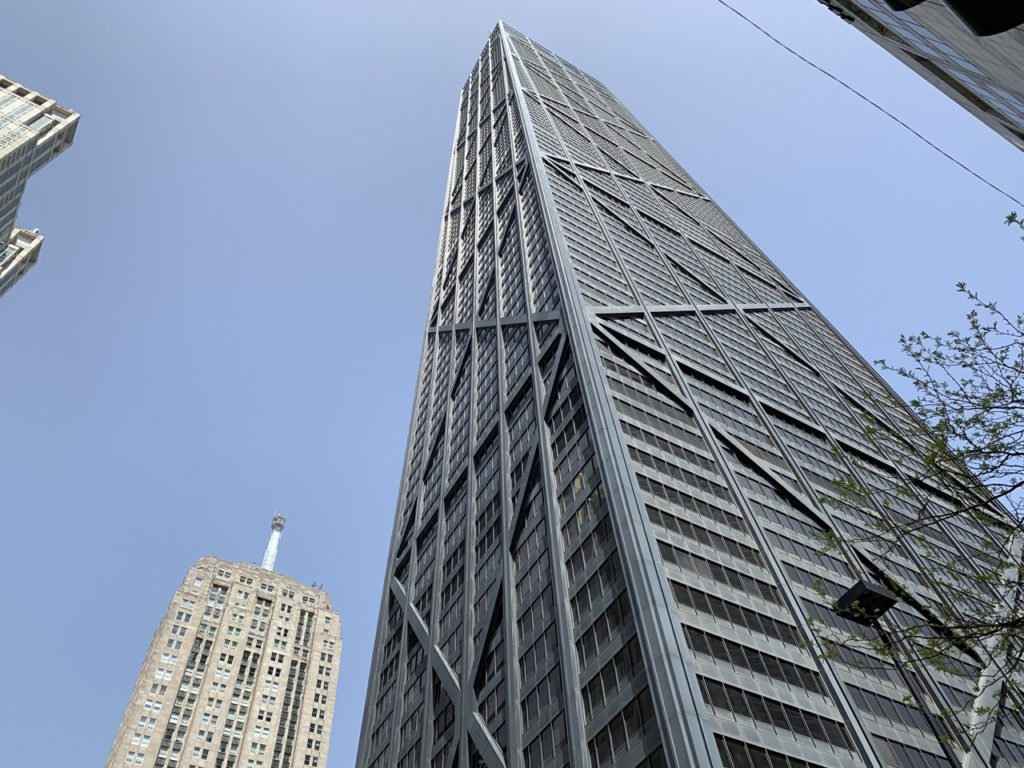
The observation deck on the 94th floor is 360Chicago and offers arguably the best views of the city.
The 95th floor’s The Signature Room and 96th floor’s The Signature Lounge are popular dining and drinking destinations for tourists looking for a view.
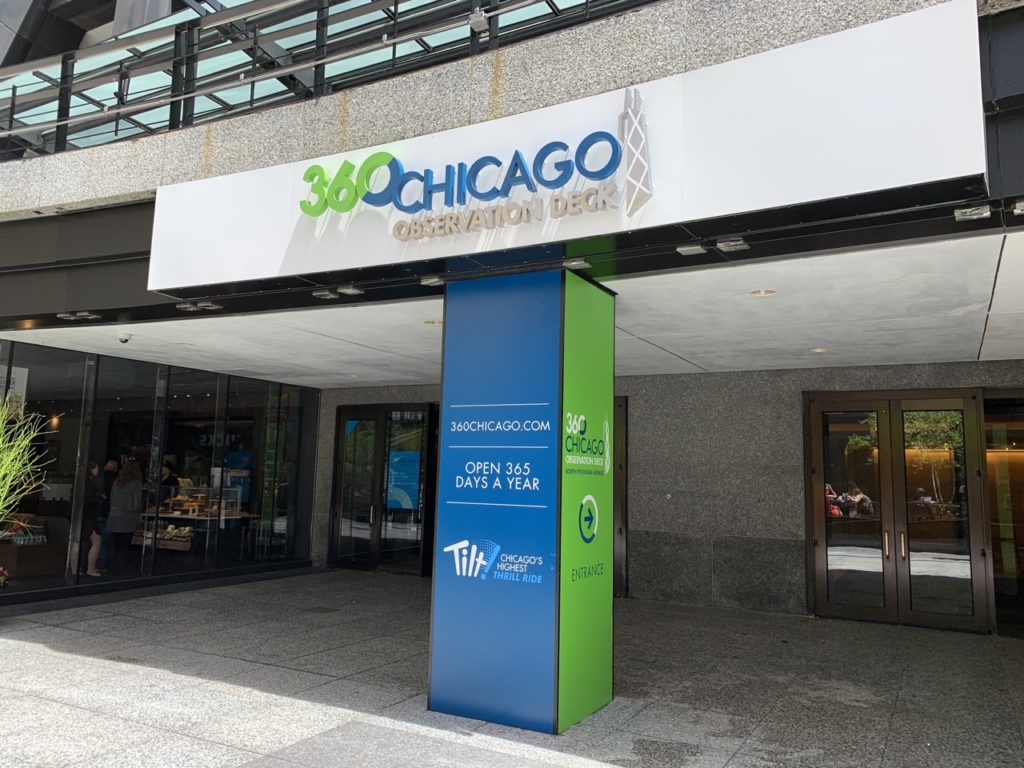
Naming rights to the building formerly belonged to John Hancock Mutual Life Insurance Company, which is in turn named after founding father John Hancock. Those naming rights terminated in 2018.
Water Tower Place
Continuing south across Chestnut, we come to our second mall, Water Tower Place.
The mall is anchored by Macy’s (formerly Marshall Fields, you can actually still spot the Marshall Fields branding in select spots in the store) and is home to the Ritz-Carlton Chicago.
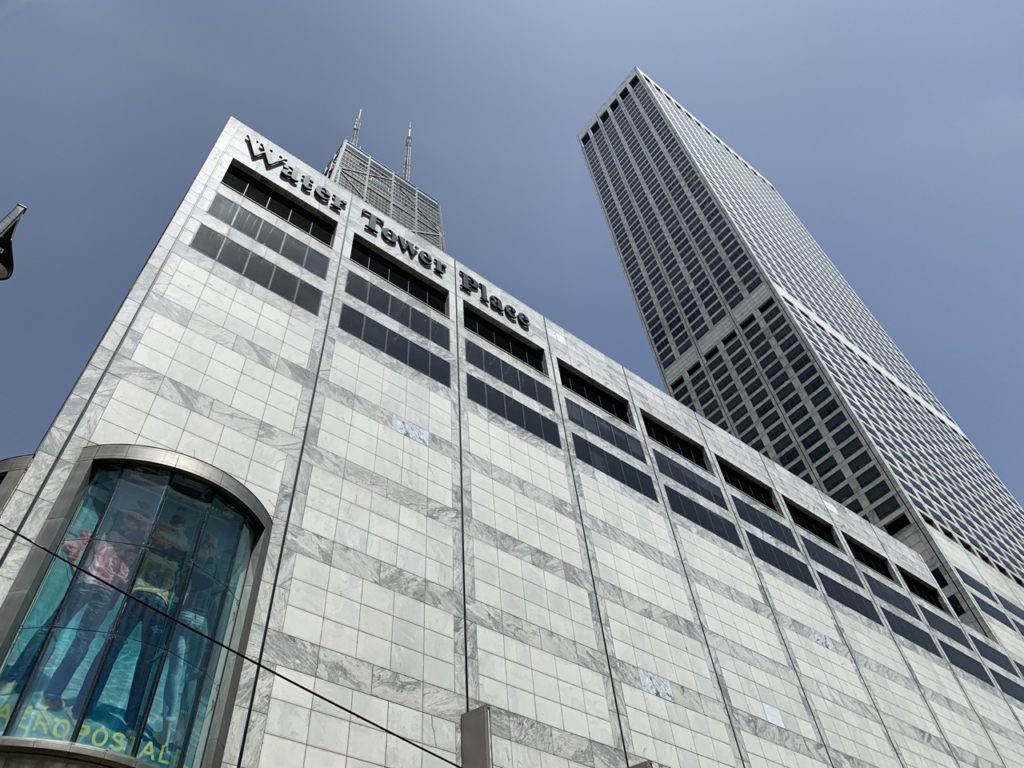
Other stores in the mall include Sephora, Abercrombie & Fitch, American Eagle, and Victoria’s Secret. It is also home to the Chicago Sports Museum.
The mall has a small walk-up Starbucks, in case you missed Oak and Rush. Across the street are H&M and Uniqlo.
Water Tower and Pumping Station
South across Pearson, we get one two of the most important historical structures in Chicago—the Water Tower and Pumping Station. The Water Tower is on west side (right, looking south)…
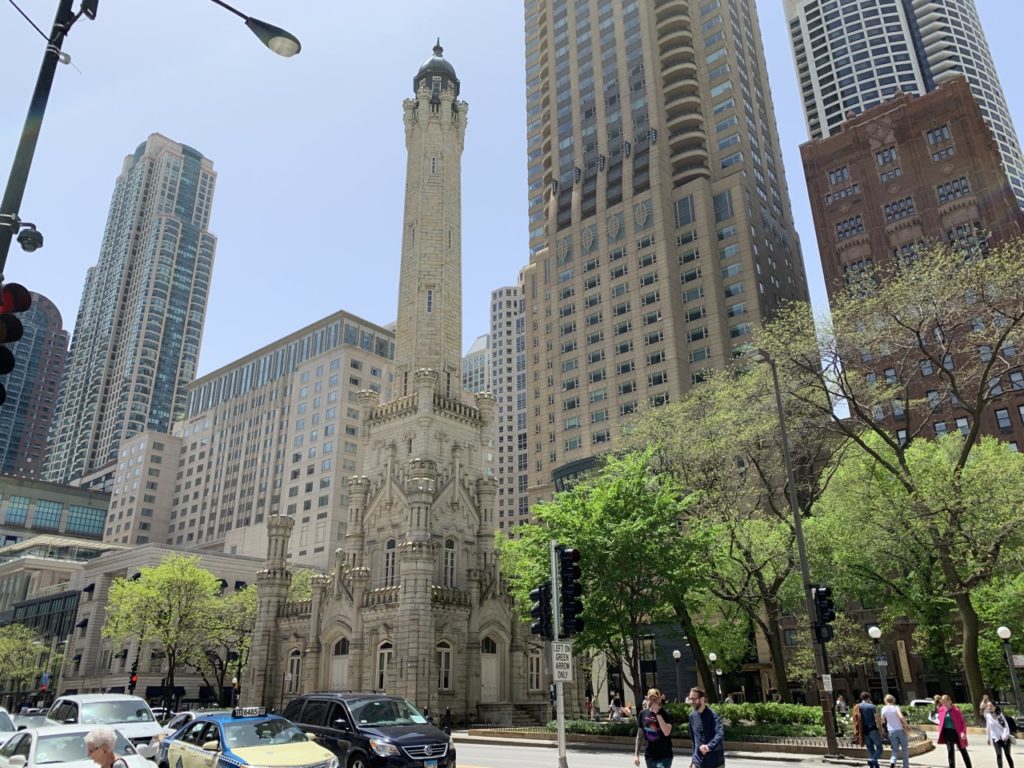
…and the Pumping Station is on the east side.

The buildings were built in 1869. A major piece of completely incorrect Chicago trivia cites the Water Tower as the only building in the city that survived the Great Chicago Fire of 1871. Actually, the fire didn’t destroy the entire city, and even within the burned zone there were a few other structures that survived.
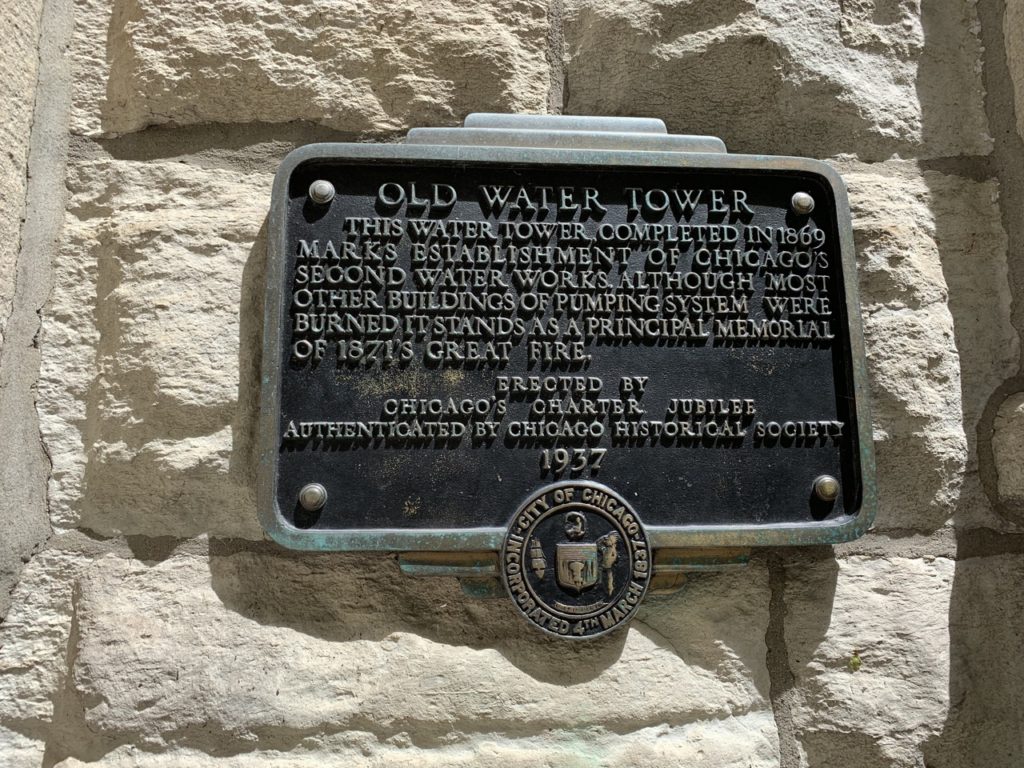
Regardless of what nits we pick, the Water Tower and Pumping Station are the most prominent structures to survive the fire, two of only a handful of buildings that survived the fire and still stand today, and icons in Chicago.
The Water Tower hosts the City Gallery in the Historic Water Tower, a gallery showcasing local artists.
Perkins, Fellows & Hamilton Office and Studio
Just west of the Water Tower, across the small park, are a few buildings, the smallest of which is occupied by a Bottega Veneta.
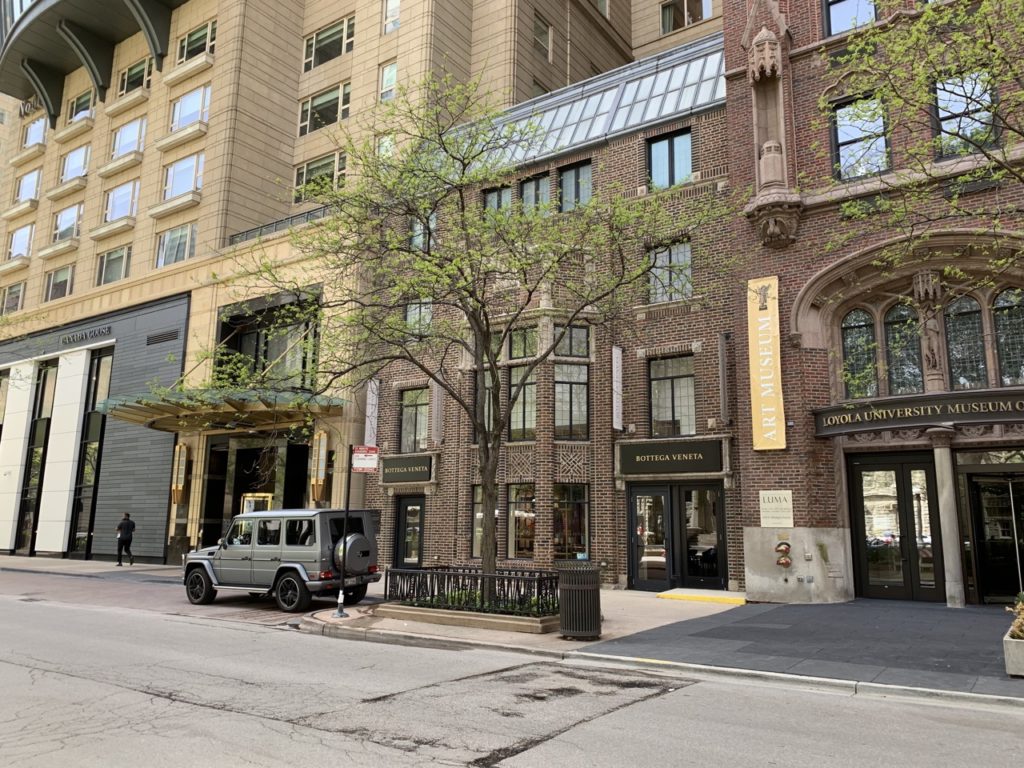
This small building was built in 1917 and is the former offices of Perkins, Fellows & Hamilton, whose lead architect Dwight H. Perkins was responsible for the design of such Chicago buildings as Lane Tech high school, Carl Schurz High School, Cafe Brauer at Lincoln Park Zoo, and the Lion House at Lincoln Park Zoo.
Chicago Fire Engine 98
If you don’t mind a little diversion, head east (left) on Chicago. You’ll quickly come upon Fire Engine 98.
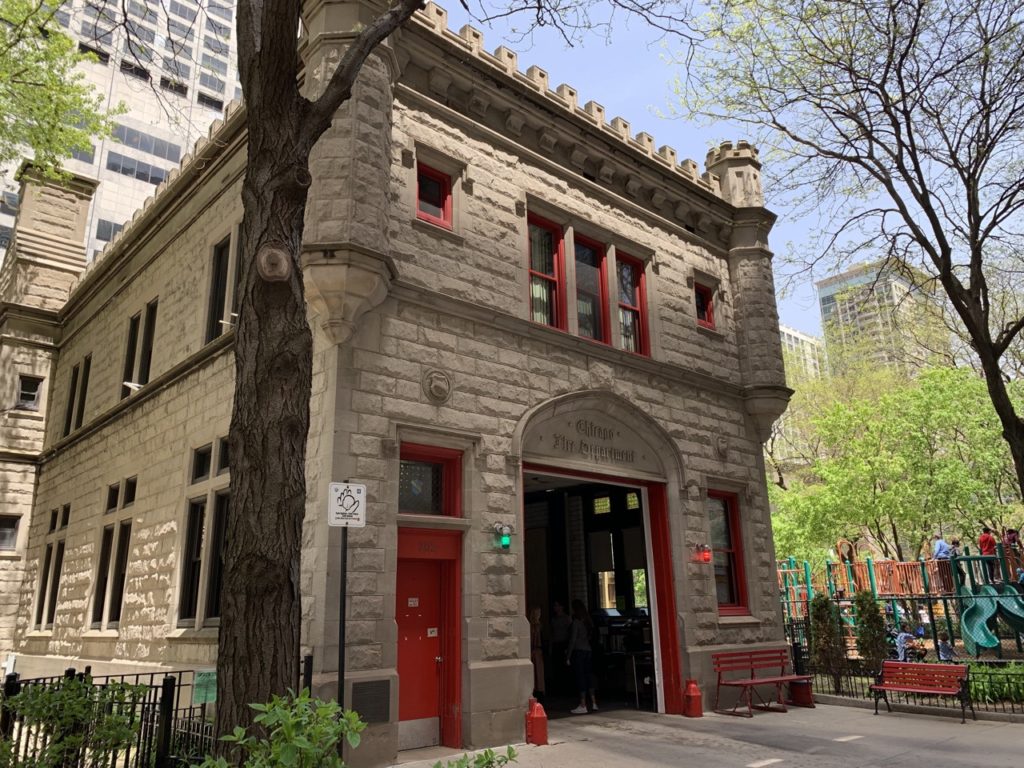
Take a minute to stop and chat with the firefighters. The building is one of, but not the, oldest firehouses in the city. It is the only one protected by a historical registry, though.
The “Chicago Fire Department” inscription above the door looks like it reads “Chirago,” but this is probably just stylistic (compare the alleged error to the other “r”s and to the “e”s).
Walgreens, Nieman Marcus, and Tiffany
The Walgreens on the southeast corner of Michigan and Chicago was the first structure to be built following the announcement of the 1947 transformation of Michigan Avenue into the Magnificent Mile. The current building was built in the 1960s.

Next to Walgreens you’ll find the Nieman Marcus department store. Across the street, among other stores, is the Mag Mile’s Tiffany & Co.
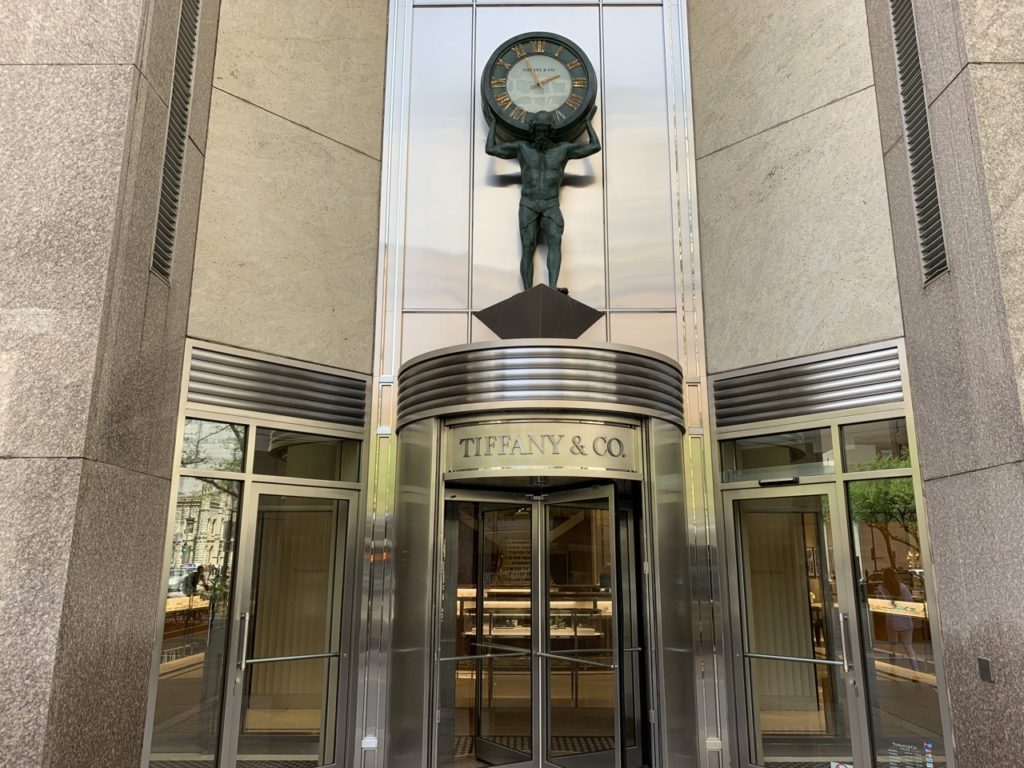
Allerton Hotel
Look up. About a block south, on the east side of Michigan at Huron is the Allerton Hotel (officially The Warwick Allerton – Chicago). Besides its architectural beauty, the building is most recognized for its prominent signage.
The Tip Top Tap, once a 23rd floor lounge, has been replaced by a ballroom. The building continues to operate as a hotel.
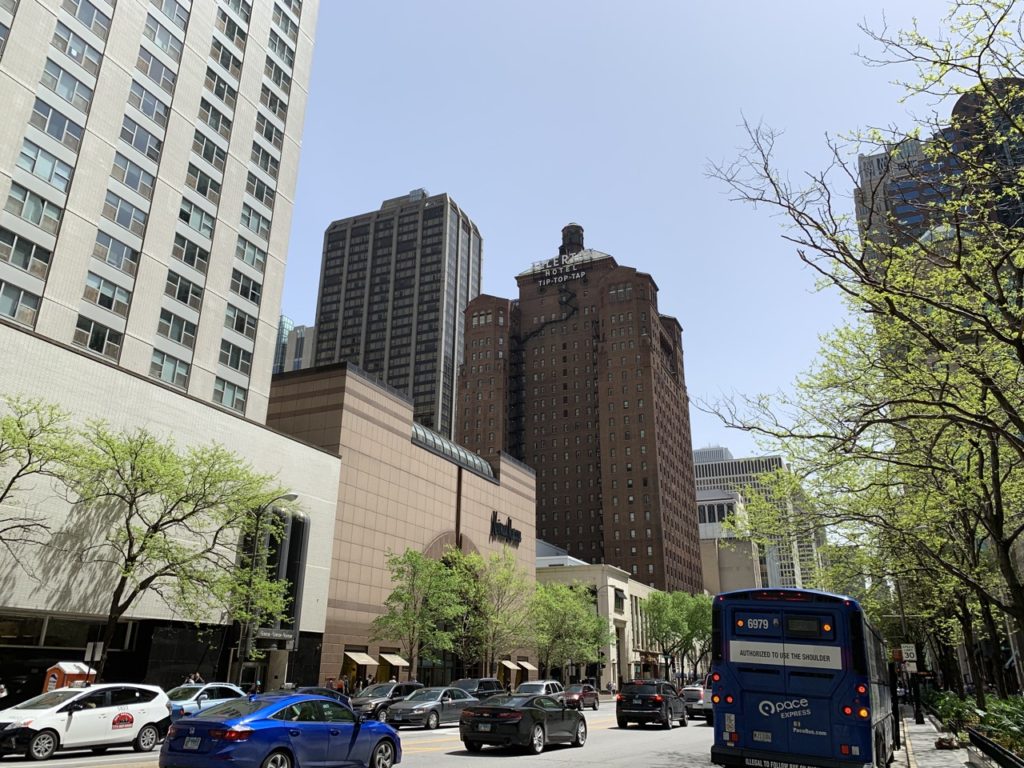
Saks, Nike, Burberry, Cartier, and Rolex
Across Michigan from the Disney Store was Saks Fifth Avenue. Continuing south, we pass by the Nike store on the east side of the street. You can usually find local musicians selling CDs in front of the Nike Store.
At the southwest corner of Michigan and Erie is the site of the massive Starbucks Reserve Roastery.
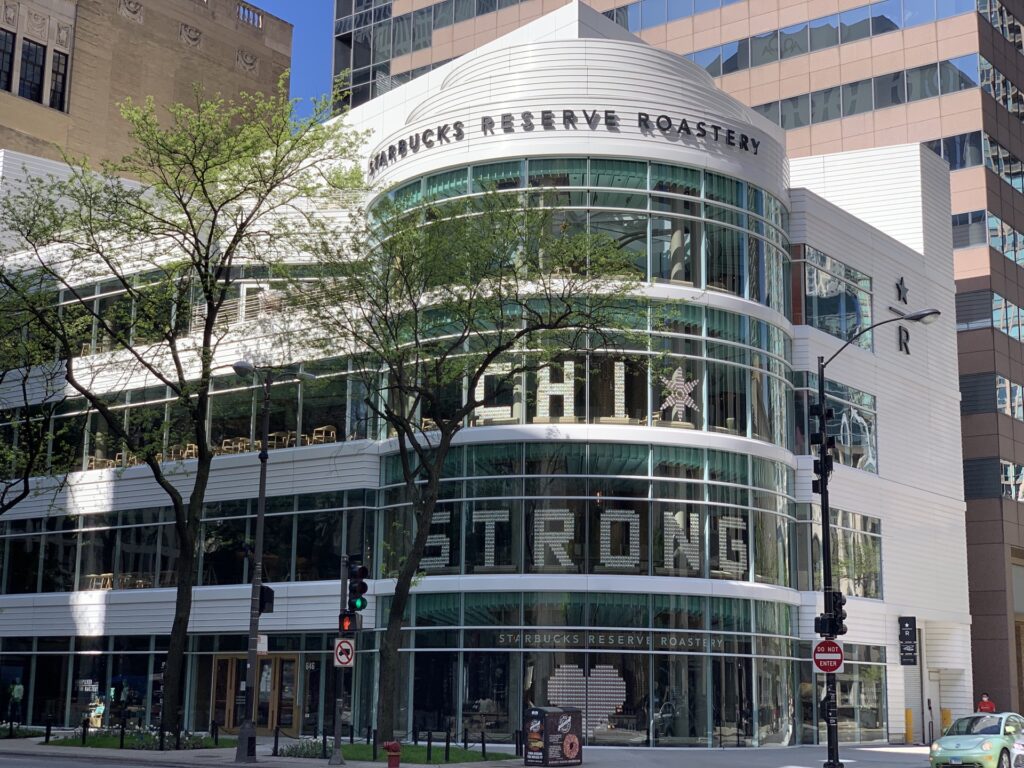
Reaching Michigan and Ontario, we have the Burberry store and its very promiment design on the northeast corner. On the northwest corner sit Cartier and Rolex stores. And above them, another historical building…
Woman’s Athletic Club
The 626 North Michigan building was built in 1928 for the Woman’s Athletic Club, which at its 1898 founding was the first athletic club for women in the United States.

Garrett, Under Armour, and an AMC
Just east on Ontario is a Garrett Popcorn Shop, in case you’re looking for a famous Chicago snack.
A block south at Ohio Street is the Under Armour Brand House, and next to it (west) is the AMC Dine In 600 Michigan, a dine-in (delivery to seat) movie theater.
Continuing past the Marriott, we come to two points of interest.
The Shops at North Bridge
We’ll start with another mall. The Shops at North Bridge is a mall located at 520 N. Michigan.

“The Shops at North Bridge” designator refers to both this structure and to the collection with a few nearby structures that share an owner.
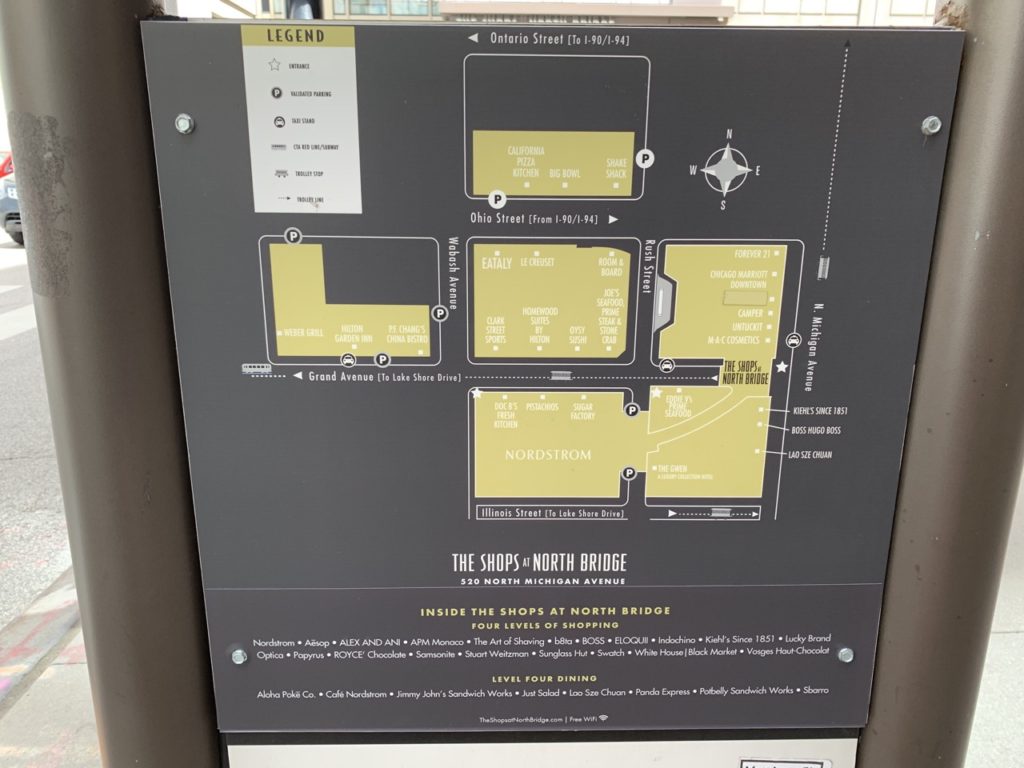
The mall is anchored by a Nordstrom. Other stores of interest include MAC, Boss, and UntuckIt, but stores tend to come and go here. Be careful where you exit because the mall has a confusing layout in relation to the neighborhood, which brings us to our next highlight…
Multi-Level Streets
Multi-Level streets are one of downtown Chicago’s trademark features.
If you enter The Shops at North Bridge through the front entrance at Grand and Michigan, go back toward Nordstrom, go to the first floor of Nordstrom, exit at Wabash and Grand, and take Grand back toward Michigan, you’ll end up under the Mag Mile, beneath where you started.

If you don’t want to take that entire journey, we still recommend taking the stairs down just for a minute to check out Lower Michigan Avenue. There’s nothing of interest down there at Grand, it’s just an opportunity to see one of Chicago’s quirkier architectural features.
McGraw-Hill Building
Honestly, if it were just another historical building (sorry, architecture buffs), I would have left the McGraw-Hill Building off this list. But this story has a twist.
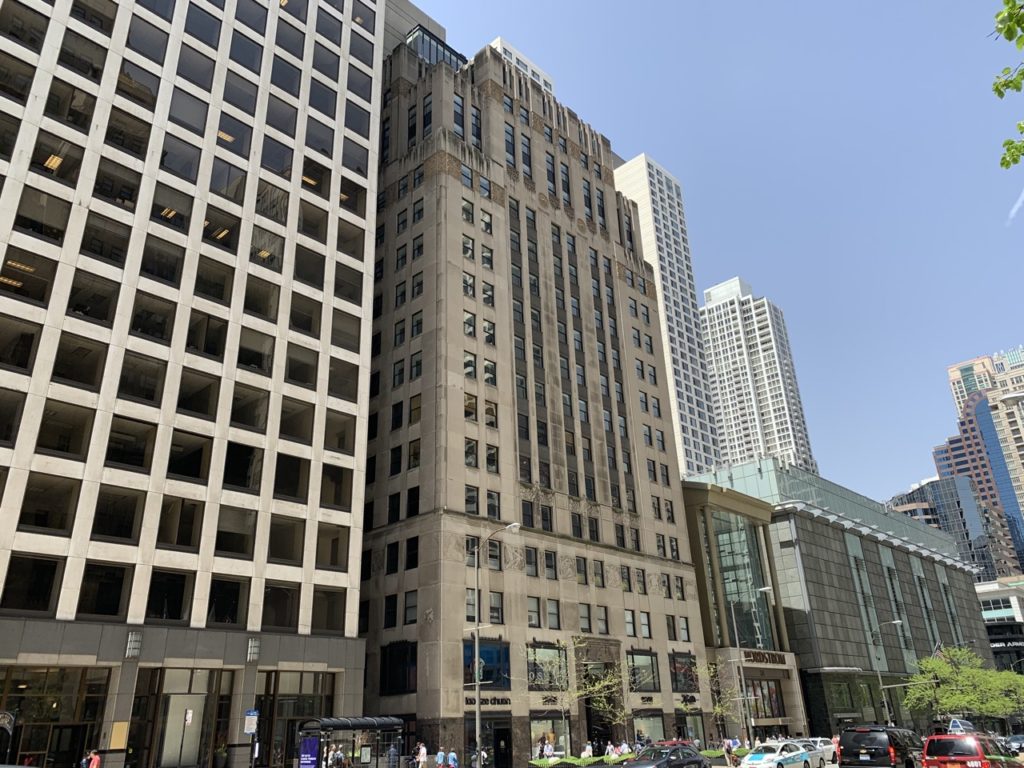
The City of Chicago’s official landmarks website discusses the McGraw-Hill Building, completed 1929, as a “rare surviving example” of the architecture of the times. The plaque agrees:
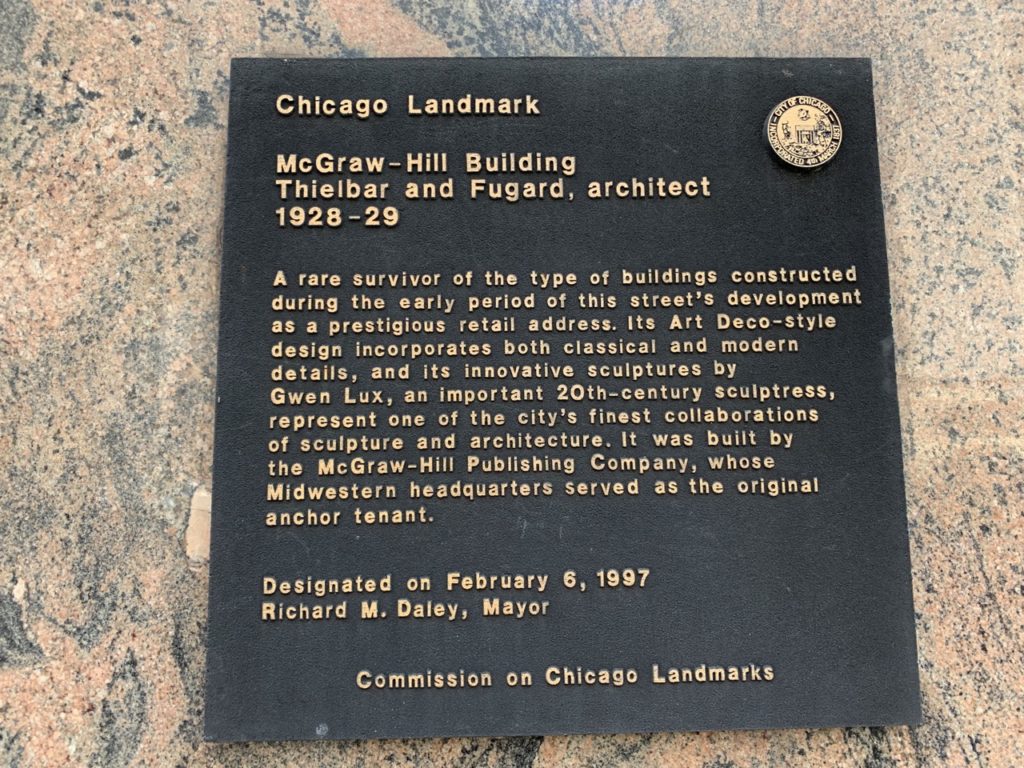
But here’s the thing—the building didn’t actually survive. It was demolished in 1998, a year after being designated a Chicago landmark.
So…what is the deal with this plaque on this admittedly 1920s-looking building? It’s a facade! (In the literal, not figurative sense.)
The entire facade of the building was dismantled into 4,000 pieces and stored in a warehouse near the Cook County Jail. As part of the Shops at North Bridge project, the facade was reinstalled on the new building in the same location as the old McGraw-Hill Building.
You can find unused pieces of the original structure inside the Shops at North Bridge.
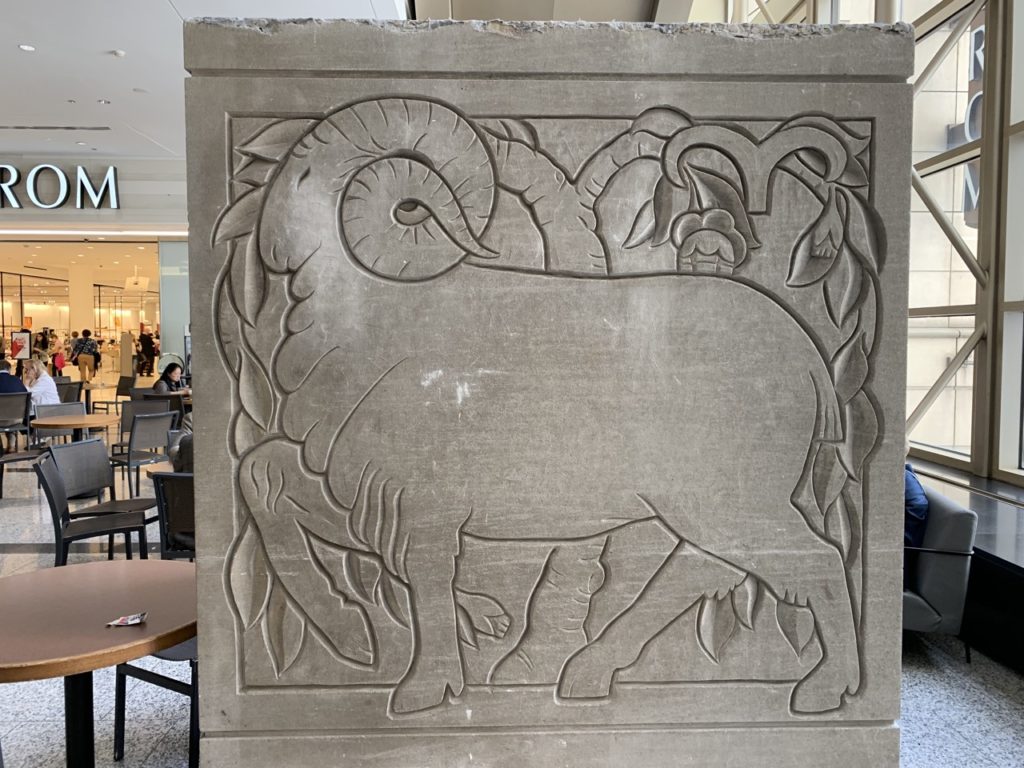
Next we’re going to take a few quick detours before closing with the four buildings at Michigan and the Chicago River.
InterContinental Chicago Magnificent Mile
Across the street is the InterContinental Chicago Magnificent Mile. The south tower was built in 1929. The panels on the four sides of the building allegedly depict the construction of a 5th Century BC Mesopotamian building.
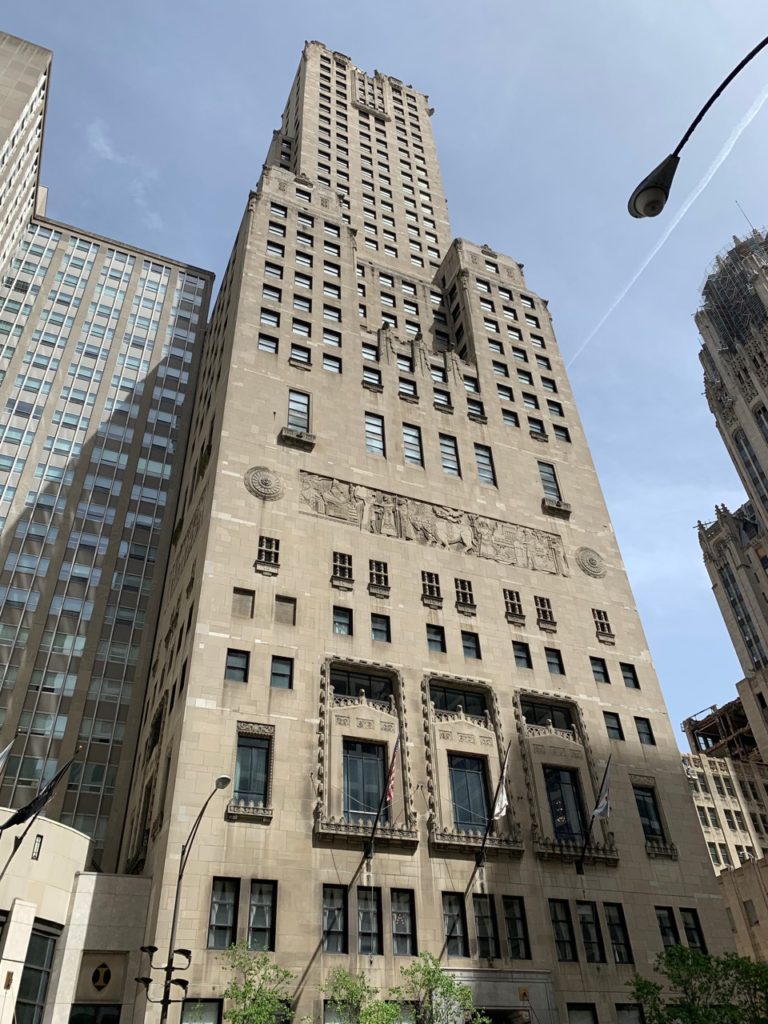
Head south past Illinois Street, past Starbucks, Charles Schwab, and Ulta, until you come to a small plaza on the righthand (west) side of Michigan.
Plaza of the Americas
Above Hubbard Street on the west side of Michigan is a small park called Plaza of the Americas. The plaza honors the countries that are members of the Organization of American States. The statue is of Benito Juarez, one of Mexico’s preeminent historical figures.
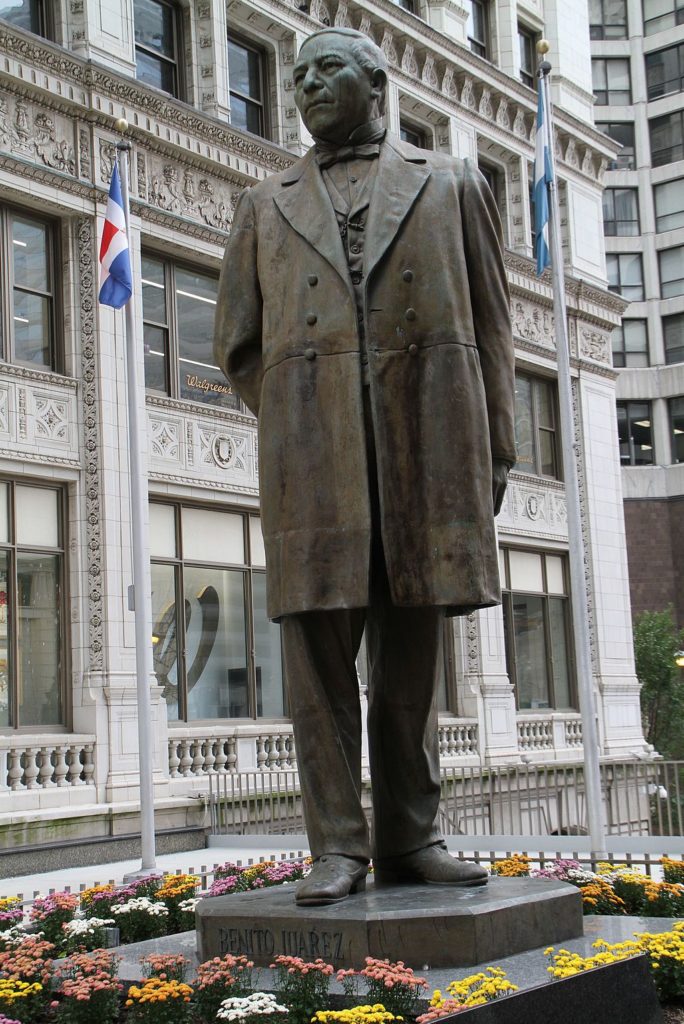
Turn back north a few steps and take the stairs down to Lower Michigan.
Billy Goat Tavern
At Lower Michigan and Hubbard (a block south of Illinois) is Billy Goat Tavern. Established in 1934 and relocated to its current spot in 1964 (though now other locations exist), the tavern is most famous for its role in two cultural institutions—Saturday Night Live and the Chicago Cubs.
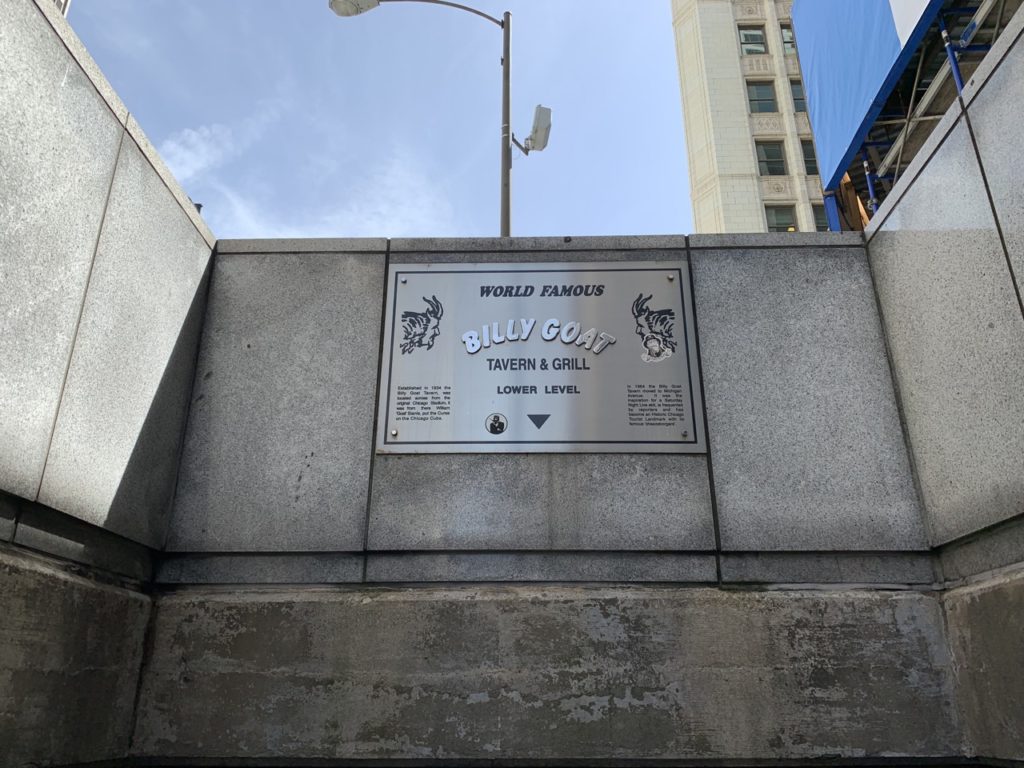
Olympia Cafe, a fictional cafe in a popular SNL sketch of the 1970s, is based on Billy Goat Tavern. The sketch is based in part on the eccentric behavior of the staff, which can still often be seen today.
As for the Cubs, they were victims of the “Curse of the Billy Goat.” Tavern owner William Sianis was asked to leave Wrigley Field during the 1945 World Series (Game 4) because the smell of his goat was bothering fans.
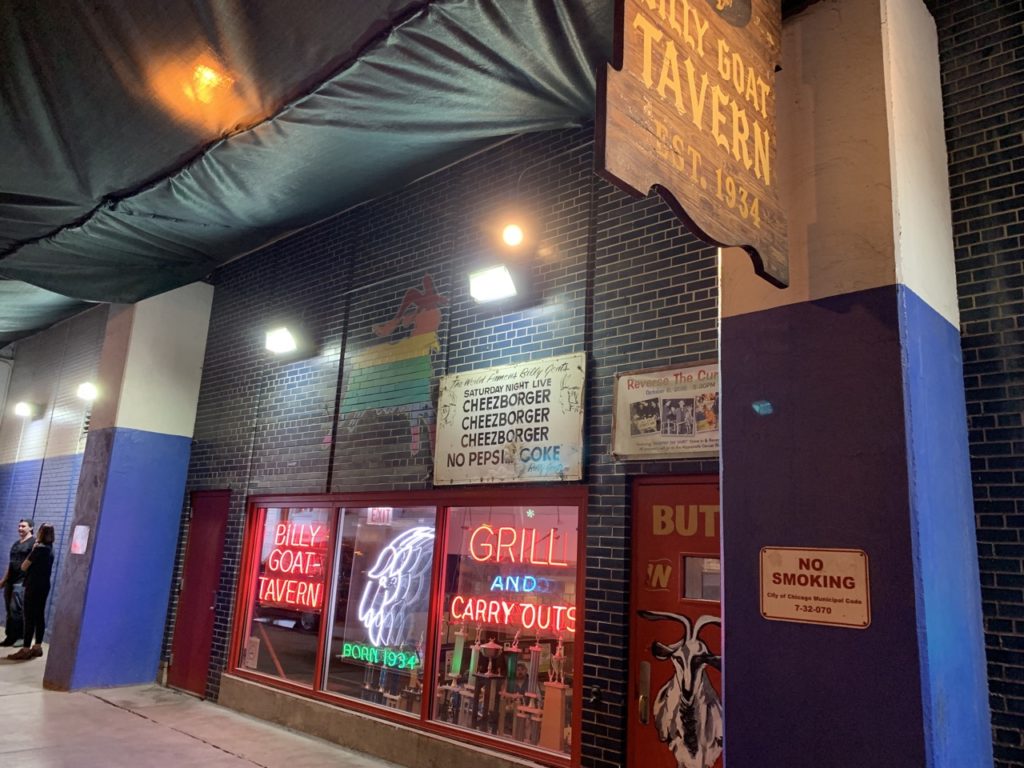
Following the insult, Sianis cursed the Cubs, thus giving birth to the Curse of the Billy Goat. The details are sketchy, but the Cubs lost the 1945 World Series and didn’t play in another World Series until 2016. The Cubs defeated the Cleveland Indians to win their first World Series since 1908.
Head back to the surface.
Tribune Tower
Just north of the northeast corner of Michigan and the Chicago River sits the Tribune Tower, the headquarters of the Chicago Tribune from its completion in 1925 to 2018.
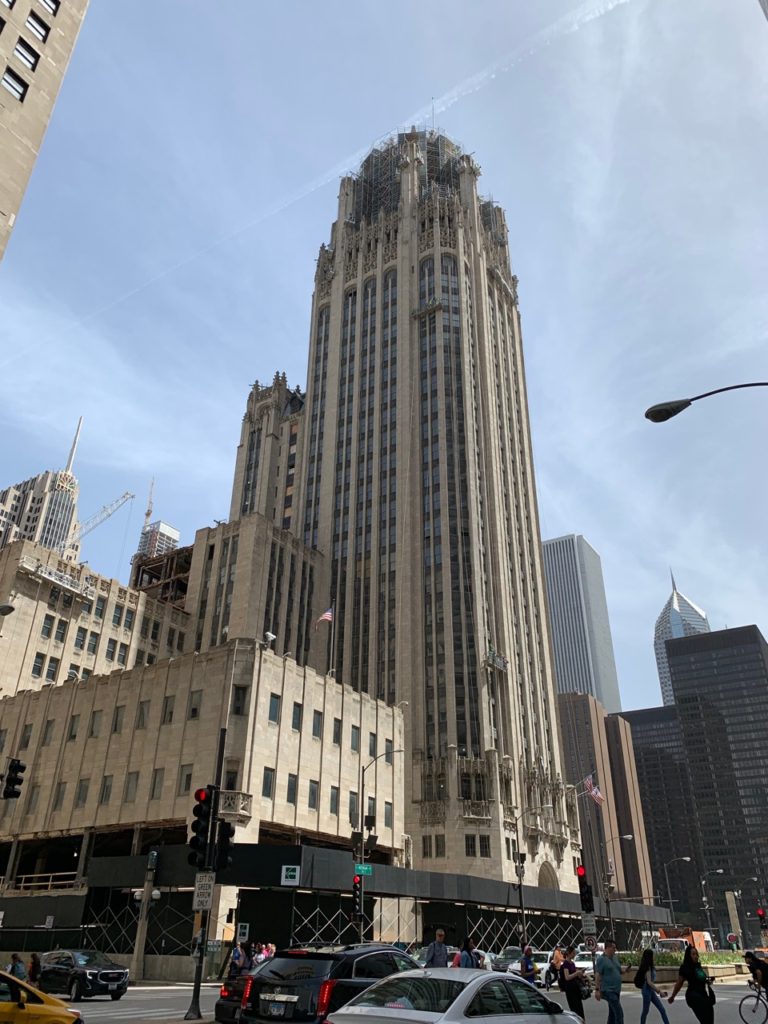
The design of the tower was the result of a design competition sponsored by the Chicago Tribune. The winning design, from architecture team John Mead Howells and Raymond Hood, is in the gothic revival style.
The Tribune Tower was one of the last examples of gothic revival skyscrapers. In the late 1920s, the Art Deco style—seen in the Palmolive Building, Woman’s Athletic Club, McGraw-Hill Building, and NBC Tower became more prominent.
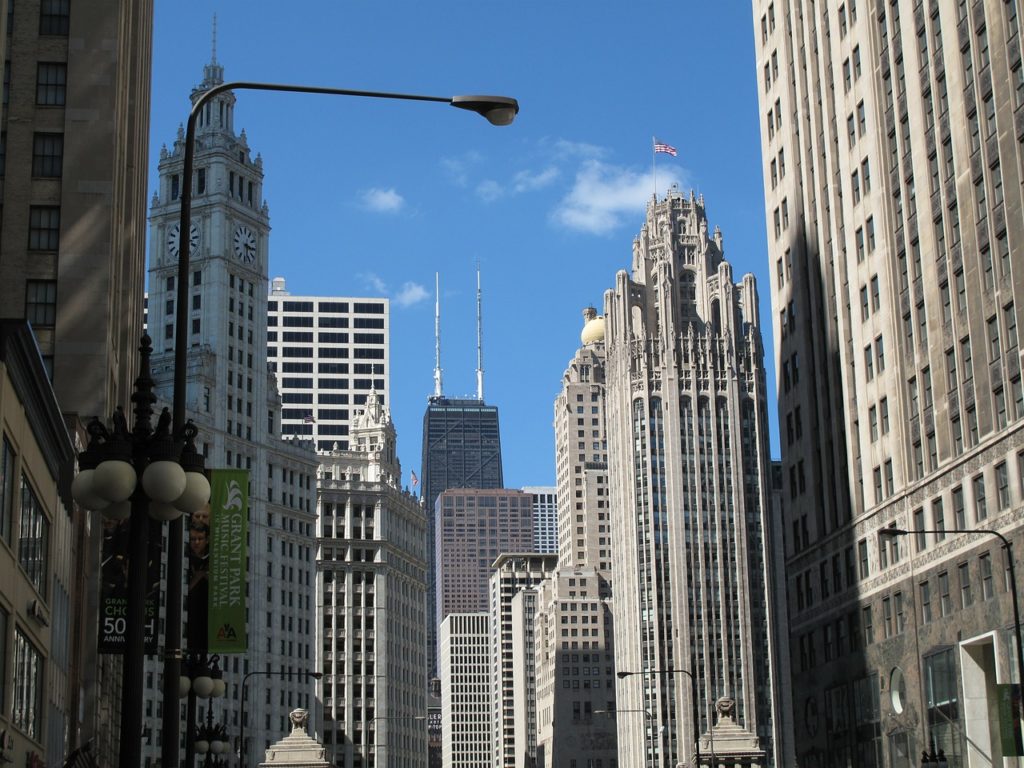
For us, the most notable architectural feature is the embedding of 150+ stones from architectural and natural landmarks around the world, including the Colosseum, Taj Mahal, and the Berlin Wall.
NBC Tower
Staying on the east side of Michigan Avenue, look left along the south side of the Tribune Tower (with the “Chicago Tribune” sign). You’ll see NBC Tower.
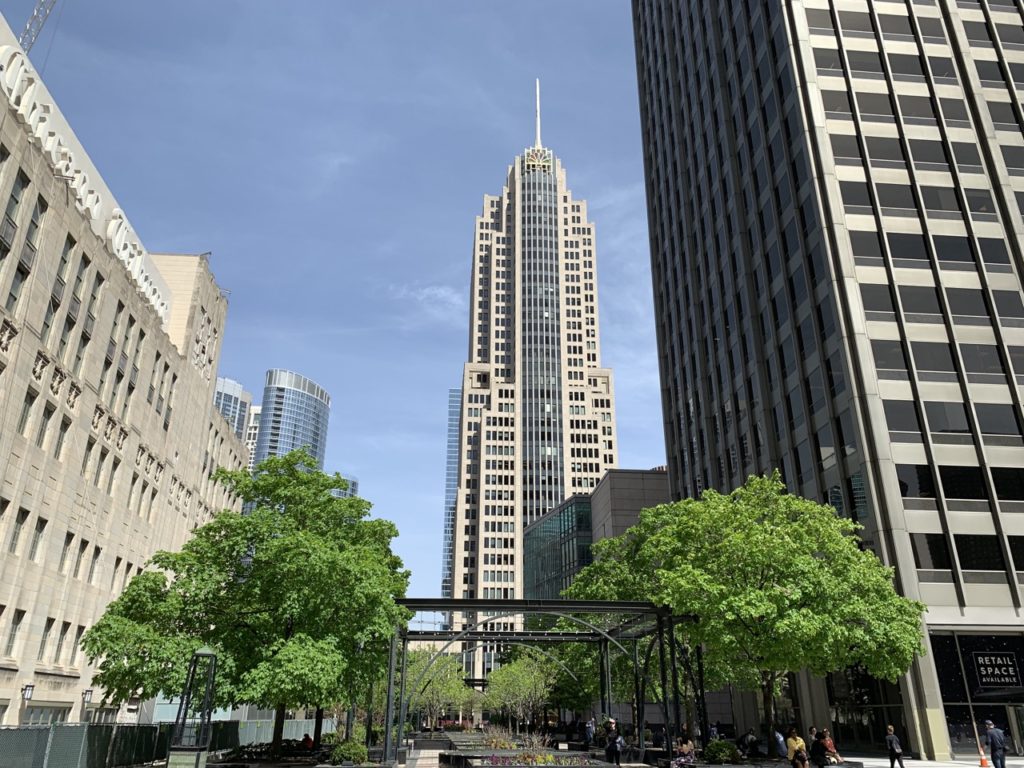
NBC Tower, despite looking like it was pulled right out of the 1920s or 1930s, was actually completed in 1989. The reason for the Art Deco design isn’t even necessarily as an homage to the buildings of Chicago. Rather, it was modeled after 30 Rockefeller Plaza, NBC’s headquarters, in New York City.
Apple Store
There are lots of cool Apple Stores in the world, and this is one of them. Located on the northeast corner of Michigan and the Chicago River, the Apple Store is a gorgeous, open space. Many days, there are as many people relaxing in and around the store as there are actual shoppers.
Jean Baptiste Point du Sable Homesite
Just next to the Apple Store, right before you get to the bridge, is our oldest historical landmark, the Jean Baptiste Point du Sable Homesite.
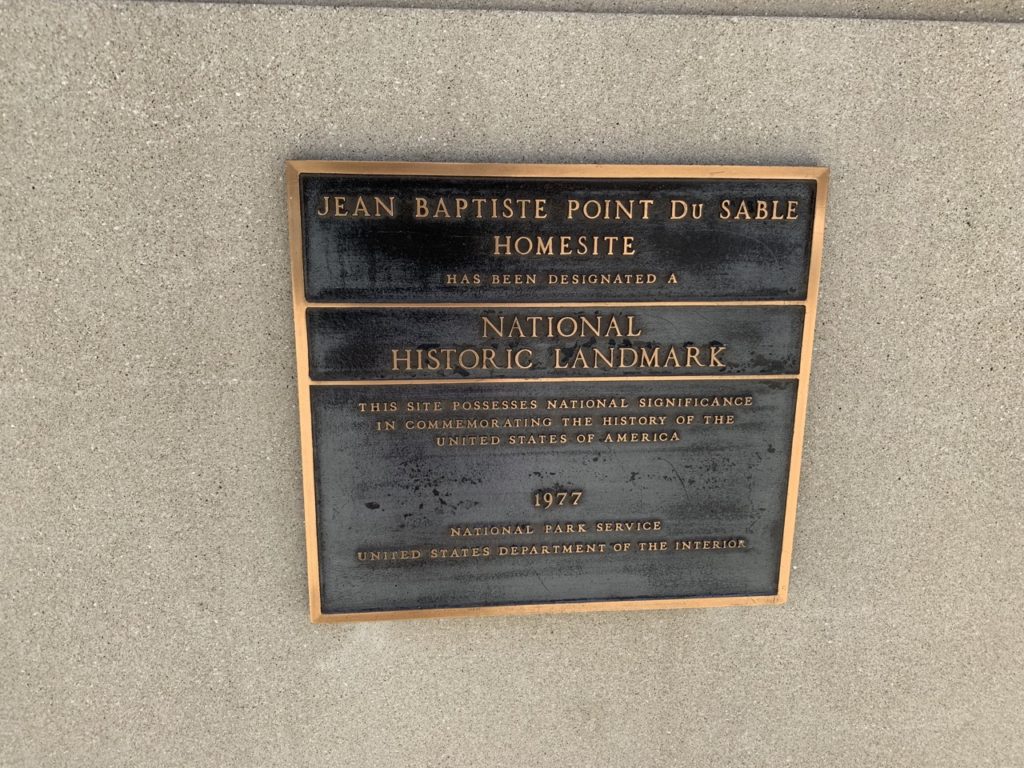
This site is the former home of Jean Baptiste Point du Sable, the first non-indigenous permanent settler of the area and often considered the founder of Chicago.
Although a bust purporting to be of Point du Sable sits at this spot, there’s no reason to trust it to be accurate, as the only records of his appearance are limited details from the journals and correspondences of his contemporaries.
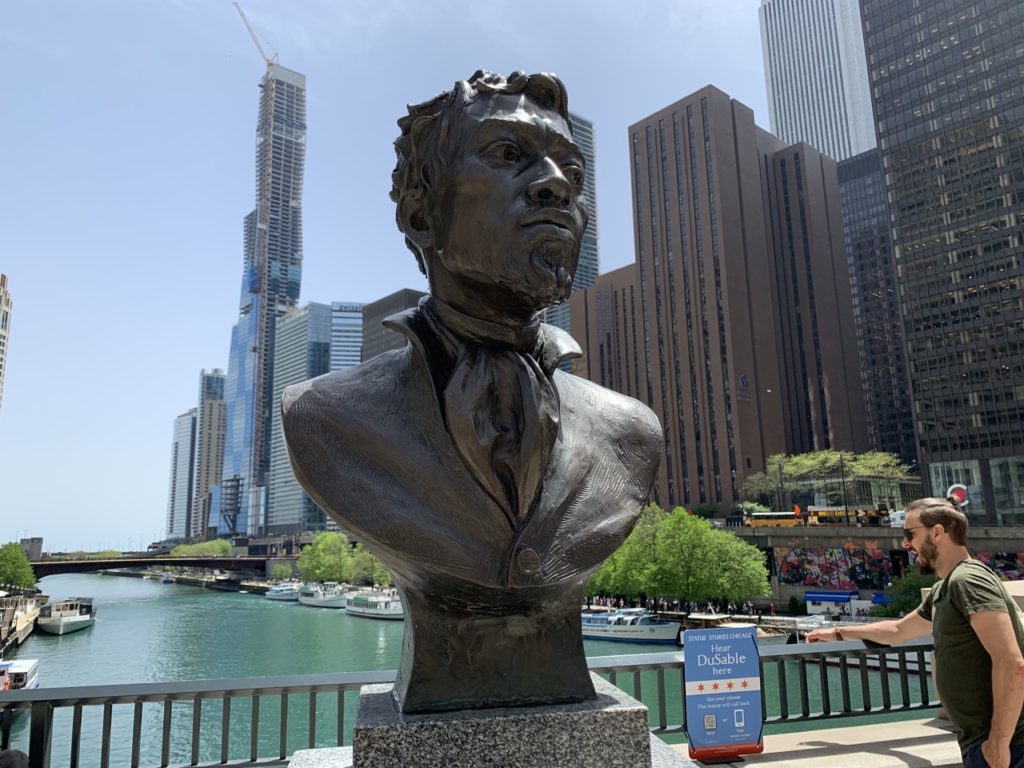
When Point du Sable arrived in the 1770s, he built his house in a natural spot—the mouth of the river. If you’re looking past the bust thinking “the mouth of the river looks about a half-mile that way,” that’s because the shoreline of Lake Michigan has significantly receded, both through natural and unnatural means, since the 1770s.
In 1821, for example, the shoreline would have been right at about St. Clair Street, roughly between your current position and NBC Tower.
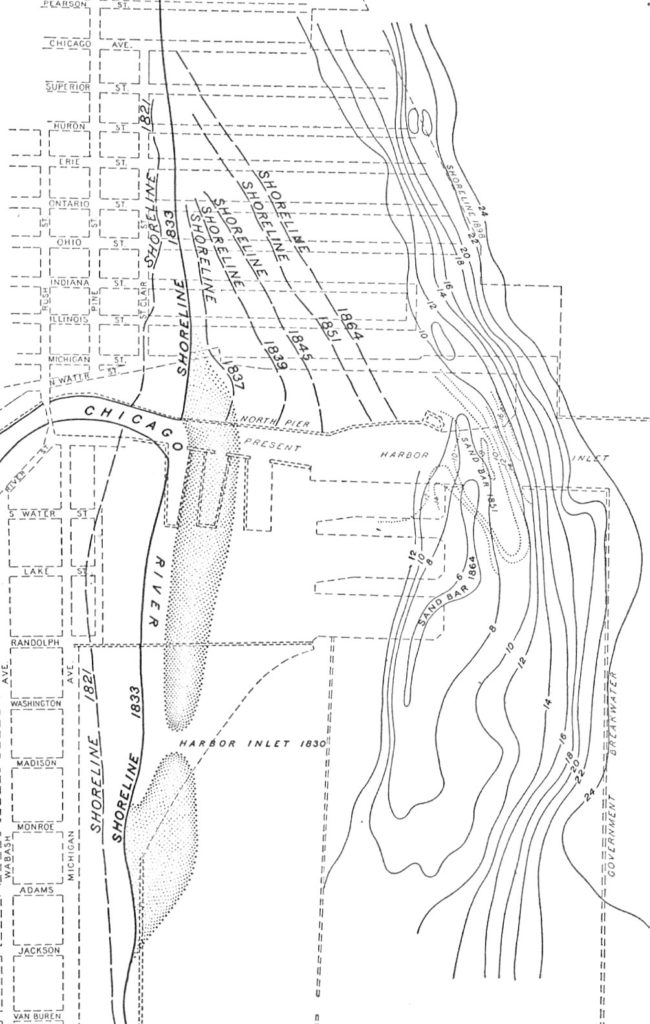
Point du Sable married a Pottawatomi woman in 1788, and the two had two children. In around 1800, Point du Sable sold the land to traders, and it became the property of John Kinzie in 1804.
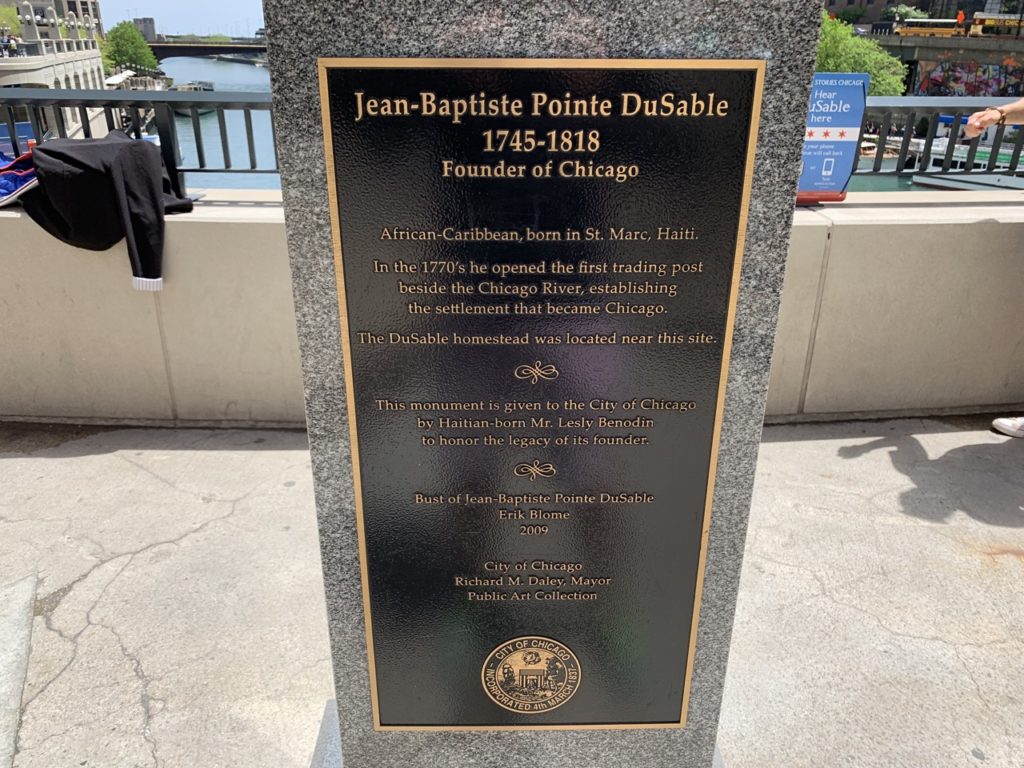
John Kinzie is also considered a founder father of Chicago, and he holds the dishonorable distinction of being the city’s first murderer. Kinzie Mansion was destroyed in 1832, four years after Kinzie’s death.
The Wrigley Building
Across Michigan Avenue, on the northwest corner of Michigan and the Chicago River, is the Wrigley Building. Completed in 1924, the building was originally built to house the Wrigley Company (the same chewing gum company whose name also adorns Wrigley Field).
The building is a blend of architectural styles, with Spanish and French influences being particularly prominent. The six shades of white terra cotta increase in brightness with the height of the building and were inspired by the “white city” architecture of Chicago’s 1893 World’s Columbian Exposition.
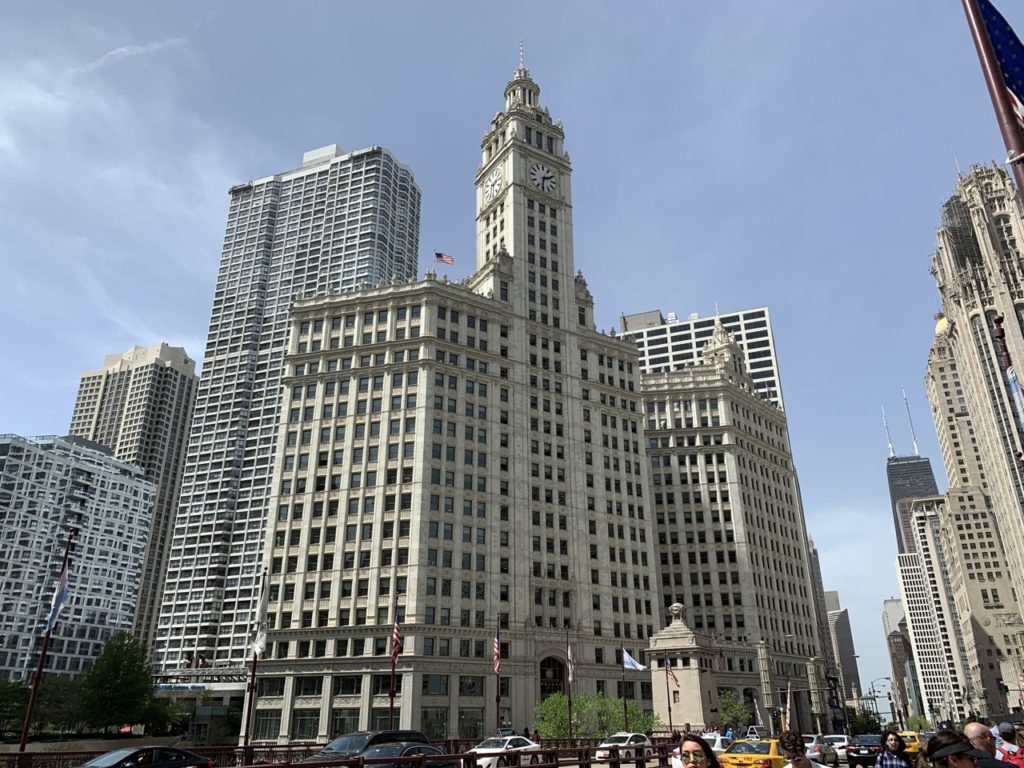
DuSable Bridge (North End)
DuSable Bridge, aka Michigan Avenue Bridge, is the bridge across the Chicago River at Michigan Avenue. As you guessed, it is named after Jean Baptiste Point du Sable.
Completed in 1920, the multi-level bridge is an obviously impressive piece of engineering. It is a popular photo spot, so take a second to snap pictures of all angles.
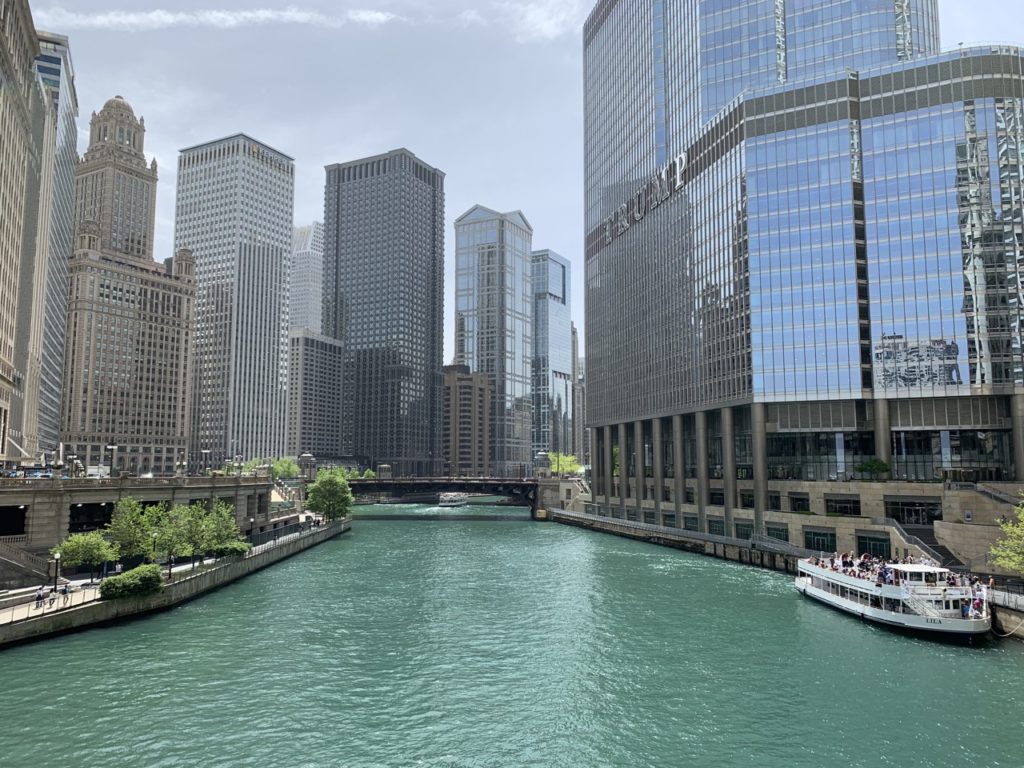
We want to highlight the sculptures adorning the four bridgehouses, beginning with the northern two.
On the northeast corner is “The Discoverers,” which depicts Louis Joliet, Jacques Marquette, René-Robert Cavelier, Sieur de La Salle and Henri de Tonti–early explorers of the region.
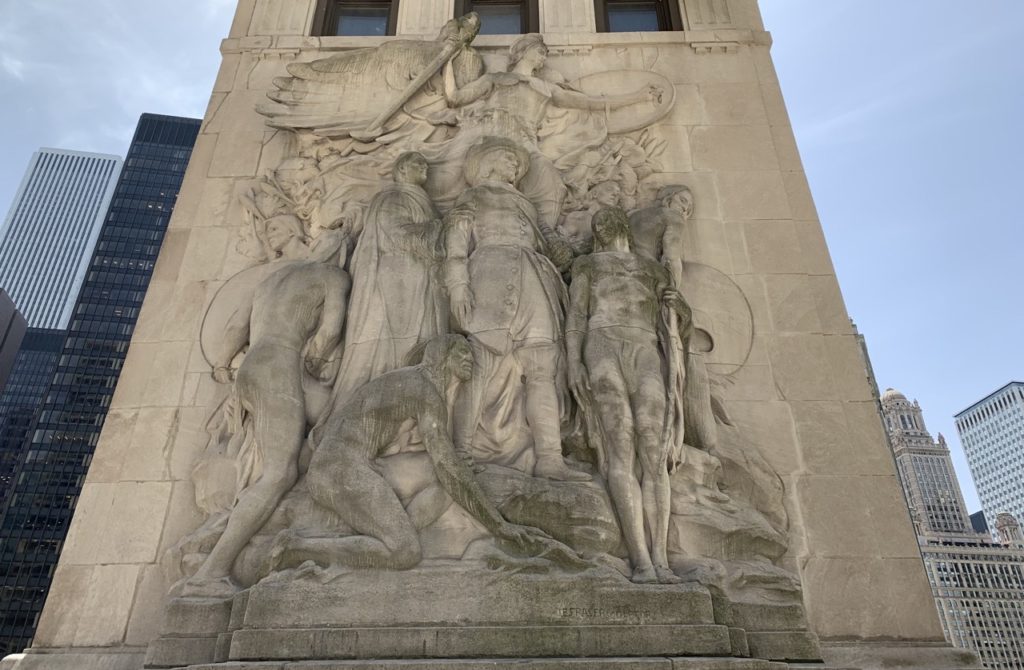
Across Michigan is “The Pioneers.” For whatever reason, there’s no inscription on this piece, but it is said to depict John Kinzie.
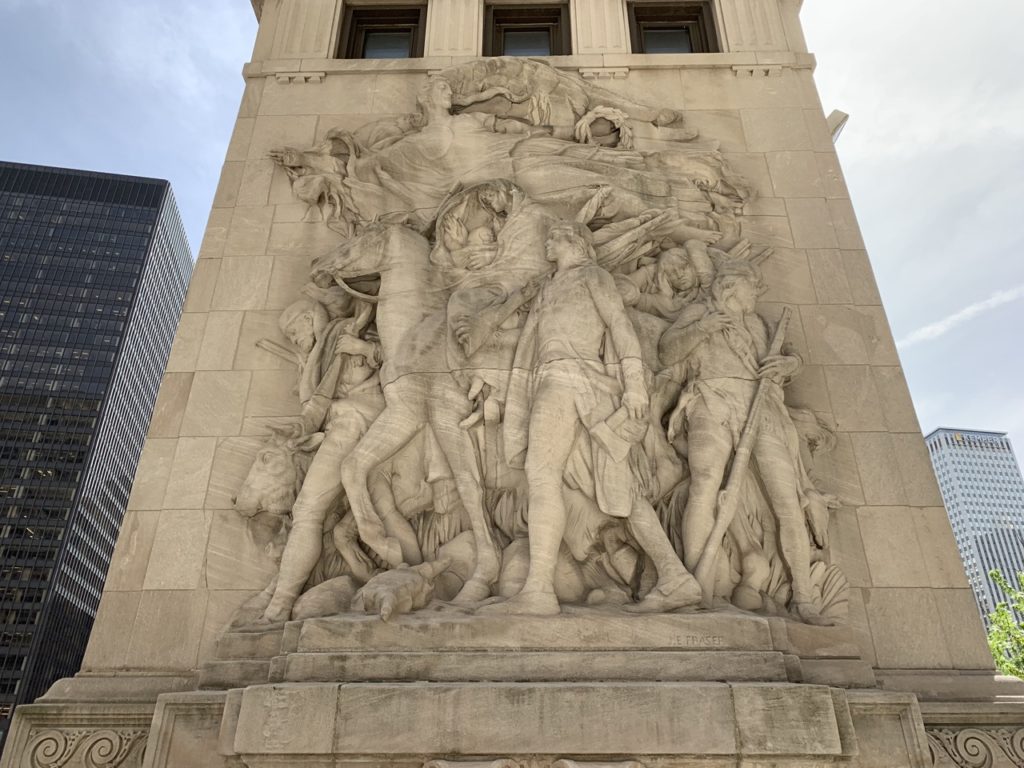
Cross the river (stopping for pictures). When you get to the southwest corner of the bridge, look down.
Fort Dearborn
Around these four corners of Michigan Avenue and Wacker Drive, you’ll see the following outline:
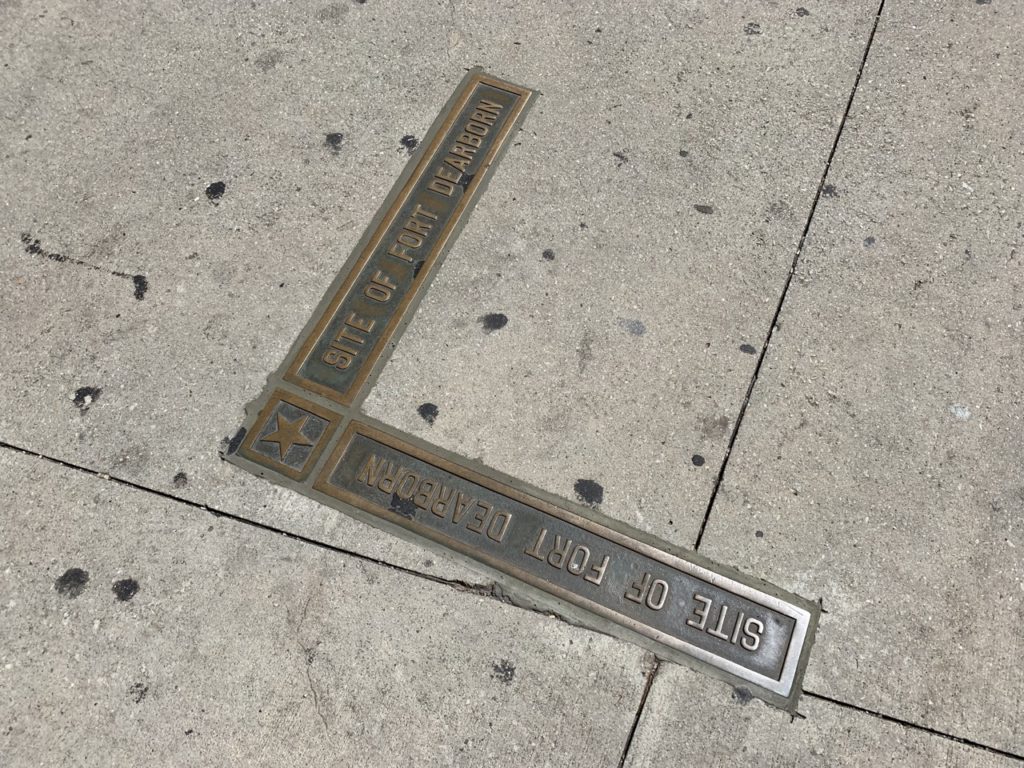
Built in 1803 and 1804 (contemporaneous with but unrelated to the arrival of John Kinzie), Fort Dearborn was part of the US military expansion into the Northwest Territory.
During the war of 1812, it became necessary to abandon the Fort. As a result of discord between the local Potawatomi tribe and the soldiers (both historical and pertaining to the circumstances of the evacuation), the Potawatomi ambushed the departing soldiers about 1.5 miles south (near Roosevelt and Michigan).
The Battle of Fort Dearborn, August 15, 1812, ended with the killing of 38 and capturing 28 of the 66 soldiers and killing 14 and capturing 13 of the 27 civilians.
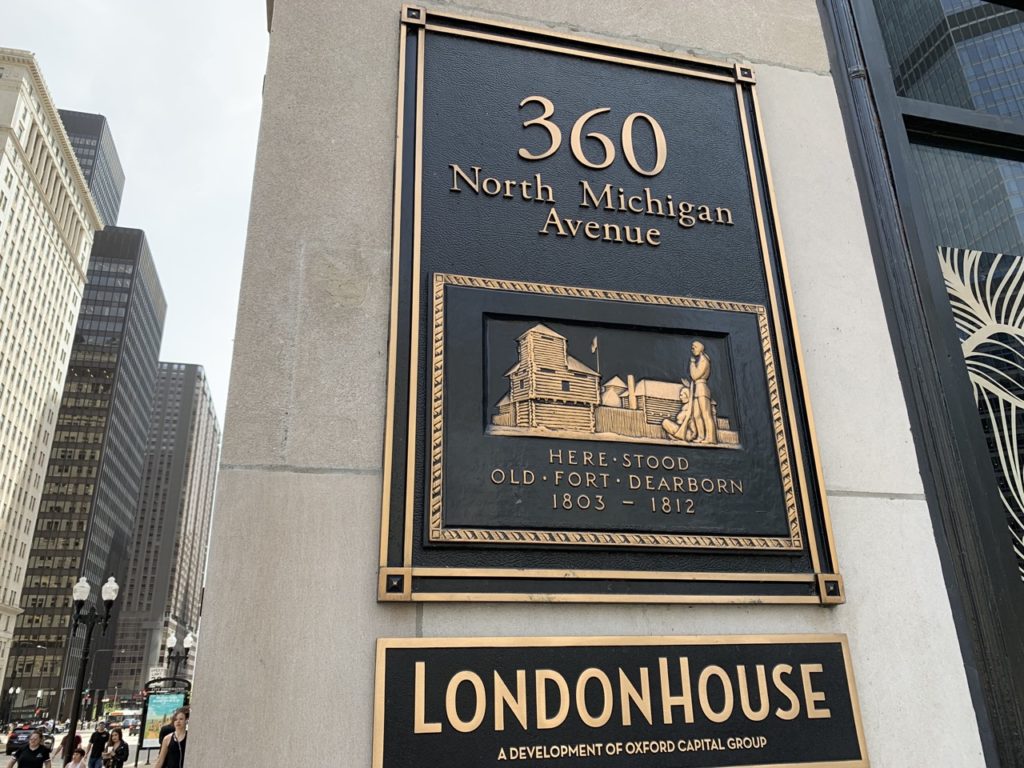
Fort Dearborn was burned the next day and rebuilt in 1816. It was intermittently used for the next few decades. Construction in the 1850s resulted in most of its destruction, with the remainder burning in the Great Chicago Fire of 1871.
Fort Dearborn is commemorated on the official Flag of Chicago by the first star. It’s also commemorated on one of the south bridgehouses of DuSable Bridge…
DuSable Bridge (South End)
The southwest sculpture titled “Defense,” depicts the Battle of Fort Dearborn.
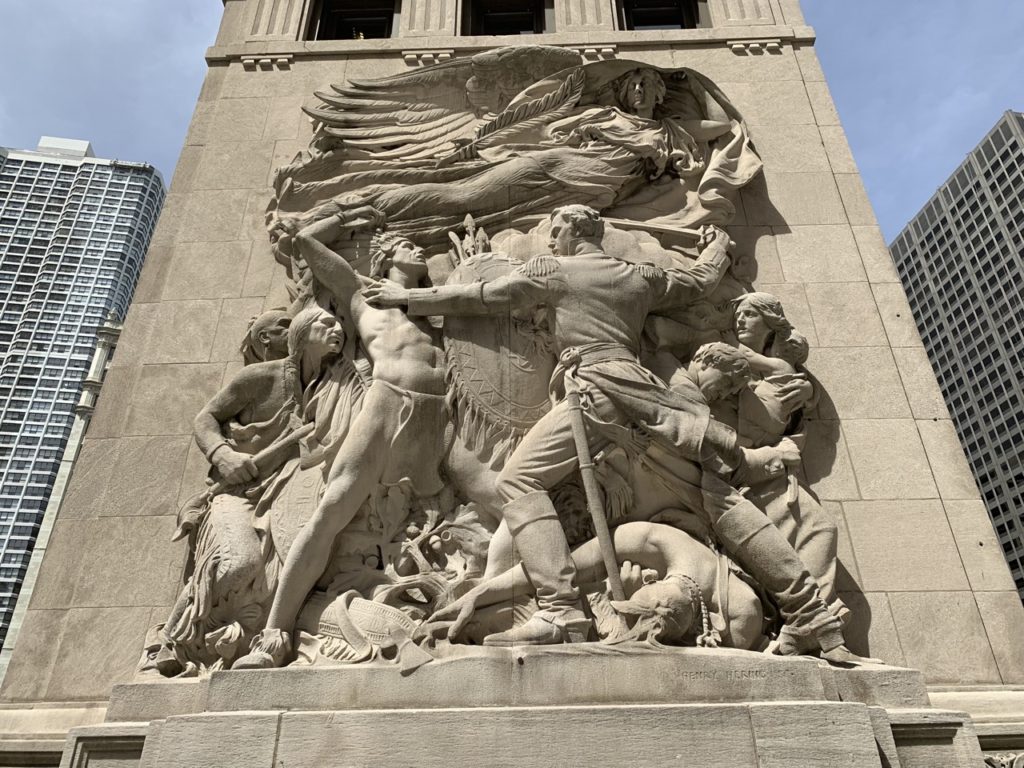
The inscription reads:
Fort Dearborn stood almost on this spot. After an heroic defense in 1812, the garrison together with women and children was forced to evacuate the Fort led forth by Captain Wells. They were brutally massacred by the Indians. The will be cherished as martyrs in our early history.
Inscription under “Defense”
Crossing Michigan, the southeast sculpture is titled “Regeneration” and depicts the rebuilding of the city after the Great Chicago Fire.
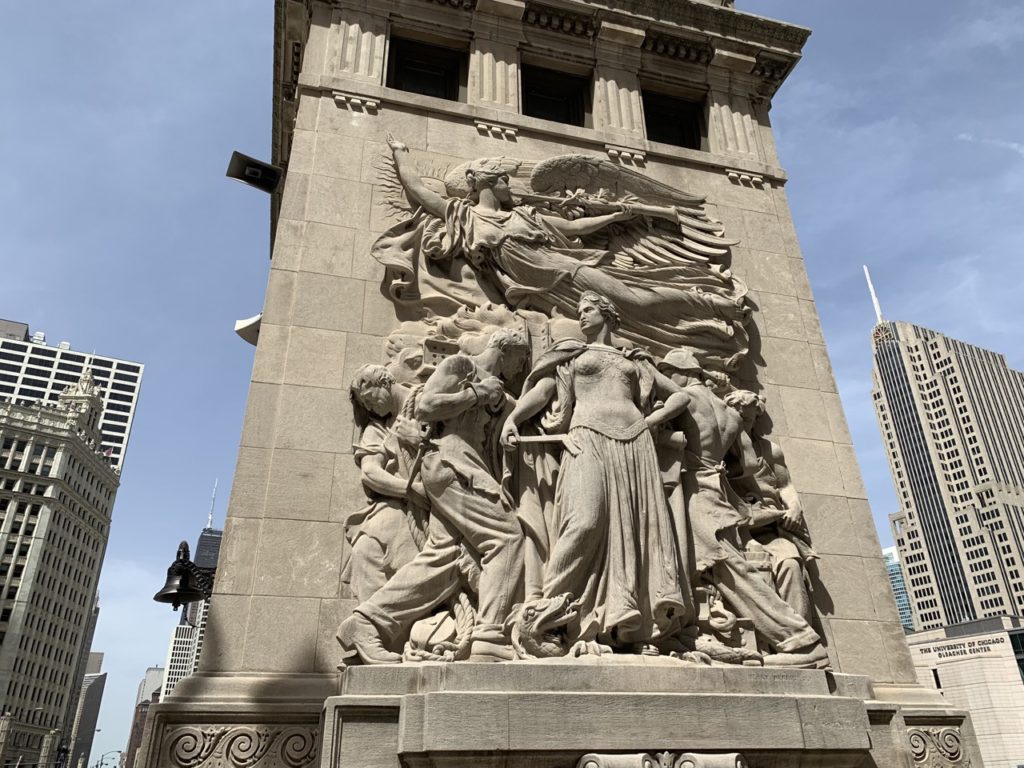
The inscription reads:
The Great Chicago Fire in October 1871 devastate the city. From its ashes, the people of Chicago caused a new and greater city to rise, imbued with that indomitable spirit and energy by which they have ever been guided.
Inscription under Regeneration
Chicago River and Riverwalk
There’s no sense in attempting to summarize the history of the Chicago River. Virtually no part of Chicago history wasn’t in some way impacted by the River (although, somewhat ironically the Great Chicago Fire crossed the river with little difficulty).
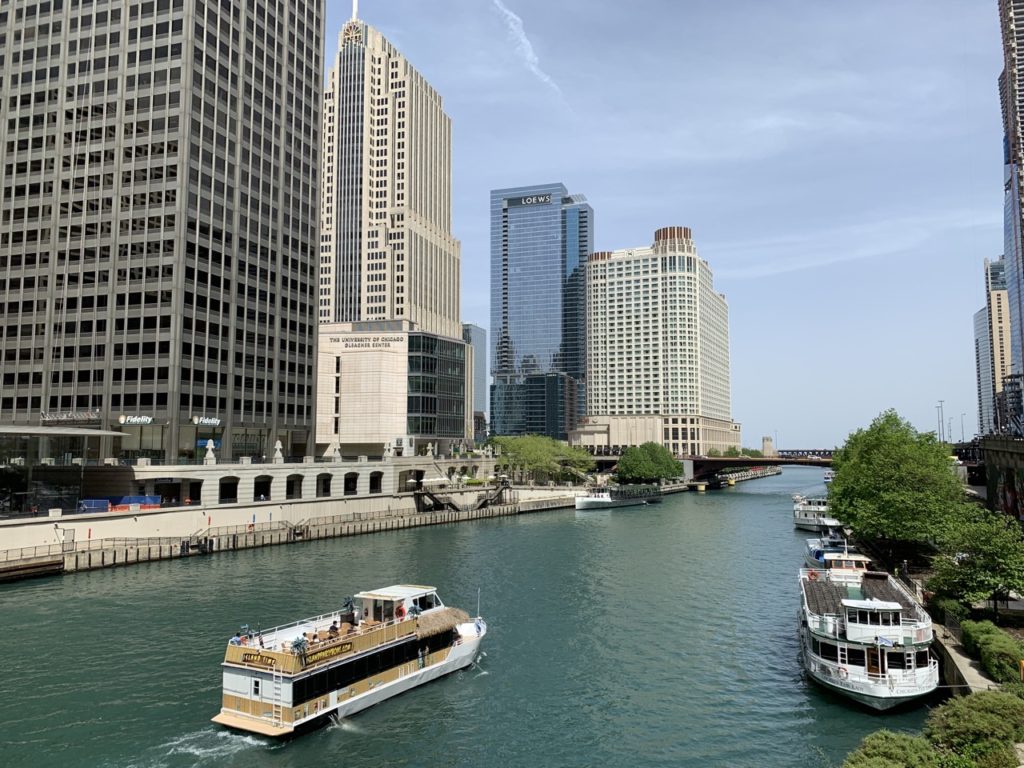
If you’d like to learn more about the river, we recommend the aforementioned Chicago River Museum. For a piece of particularly interesting history, read about the reversal of the river.
Along the south bank of the river from Lake Michigan (in the east) to Lake and Wacker (in the west) is the Chicago Riverwalk. The 1.25-mile path is filled with bars, restaurants, activities, memorials, and beautiful views.
South of the Chicago River
Before we end the tour, we need to mention four buildings south of the Chicago River. Though not a part of the Magnificent Mile, they must be mentioned alongside any discussion of the Michigan Avenue / Chicago River intersection.
Crossing the Chicago River, the angled building on the southwest corner is the London Guarantee Building, completed in 1923.
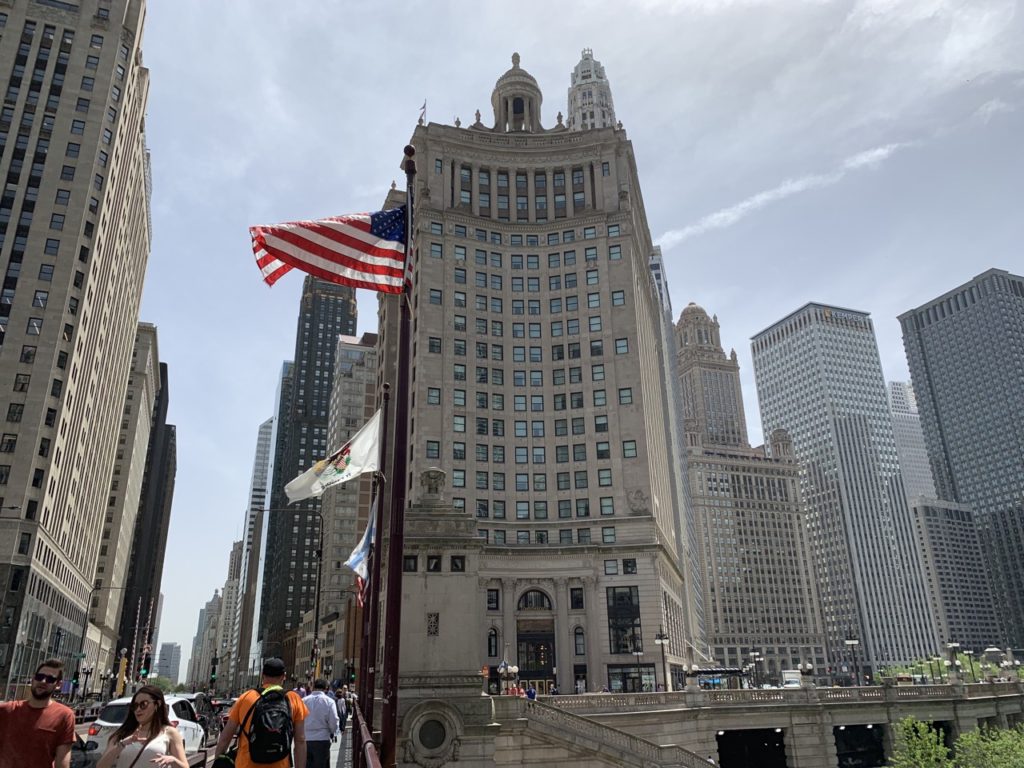
The design is the “epitome of the Beaux-Arts style” and, like the Wrigley Building, drew inspiration from the 1893 World’s Columbian Exposition. A plaque above the main entrance commemorates the site of Fort Dearborn, which we will return to shortly.
Across Michigan Avenue from the London Guarantee Building, on the southeast corner, sits 333 North Michigan, completed 1928. Despite the prominent of Art Deco architecture at the time, this is the only one of the four buildings at this historical intersection to built in the Art Deco style.
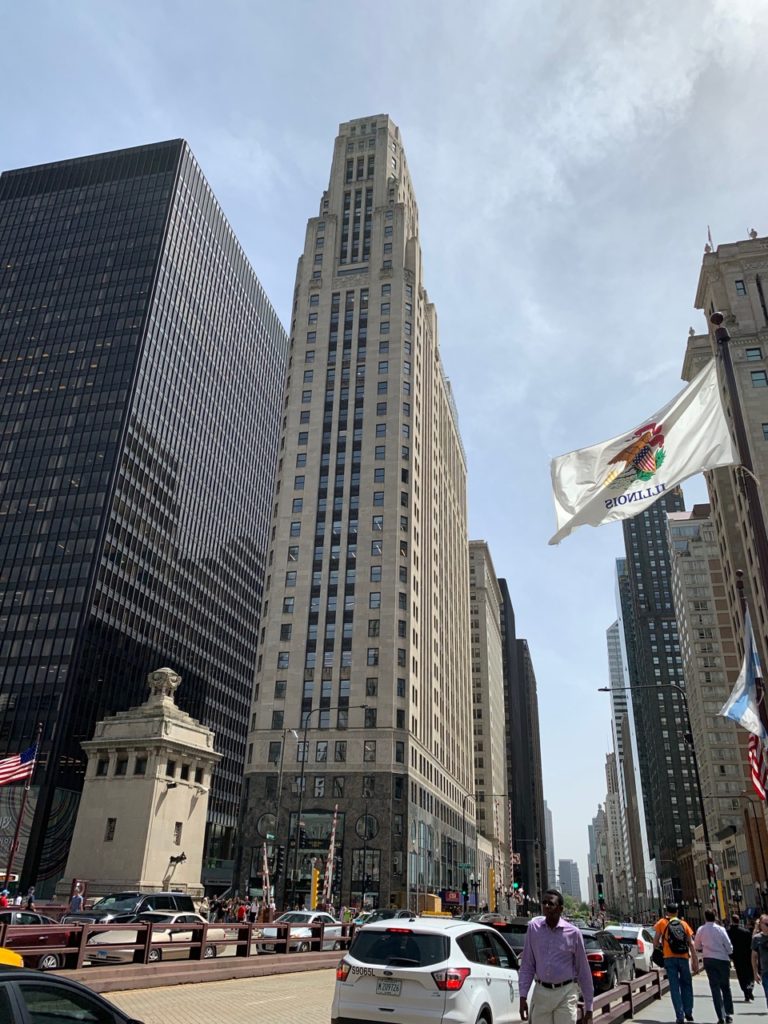
Mather Tower, just west of the London Guarantee Building, is the city’s most slender skyscraper and another example of late Gothic Revival architecture (completed 1928).
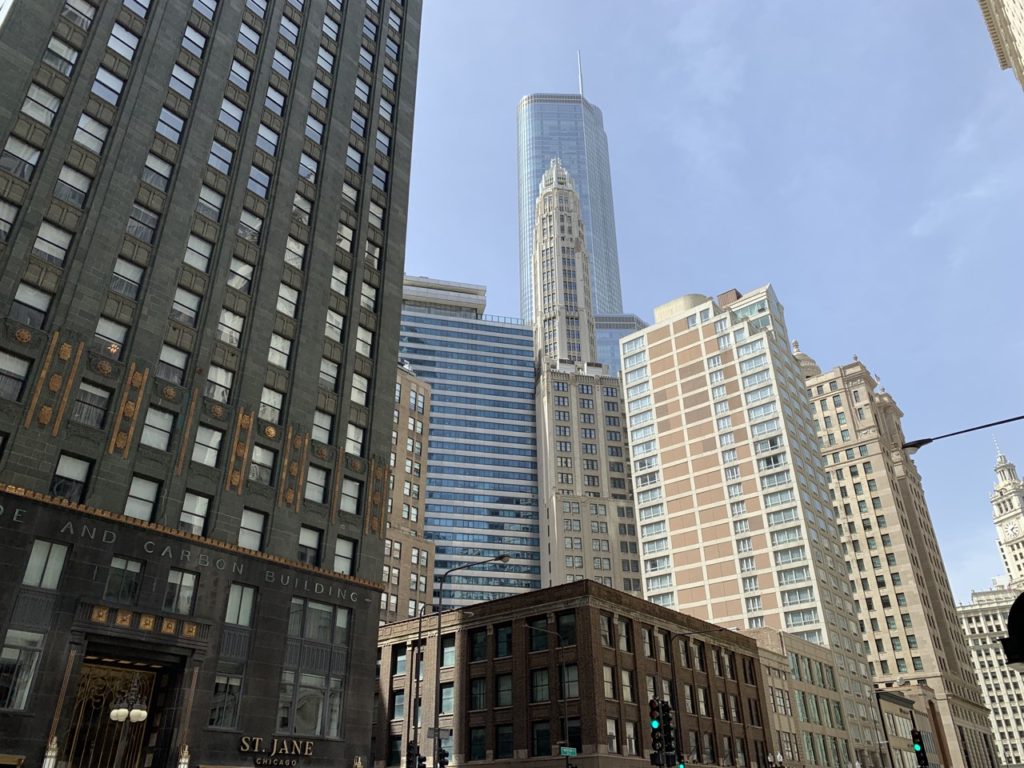
The Carbide & Carbon Building, just south of the London Guarantee Building, is a stunning Art Deco skyscraper, completed in 1929. With its dark green color and gold top, it is said to resemble a champagne bottle.

This ends our walking tour of the Magnificent Mile. Whether you’re wrapping up at the north end or the south end, there’s plenty more to be seen in this part of the city…
What’s Nearby
A lot. A lot is nearby.
Oak Street and Oak Street Beach
Also covered in the walking tour above, Oak Street between Michigan and Rush is the highest end shopping strip in the city. Oak Street Beach, accessible from the north end of the Mag Mile, is one of the city’s popular beaches.
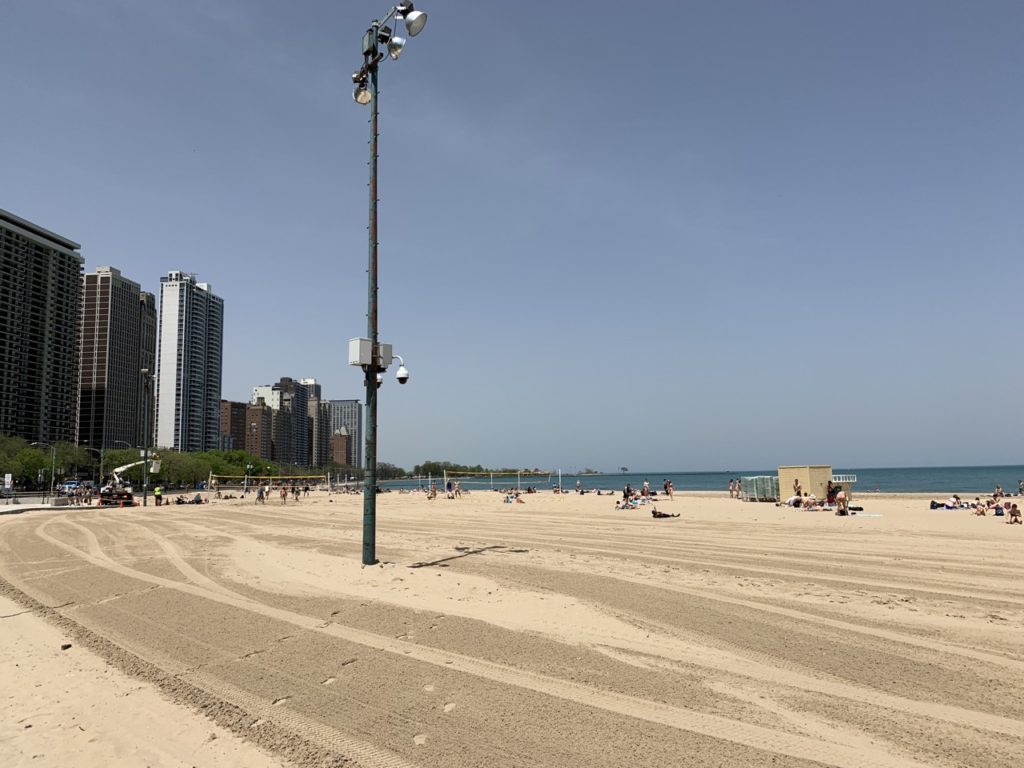
Gold Coast, Lincoln Park, and North Avenue Beach
Walk north and you’ll pass through Gold Coast and reach Lincoln Park, which includes Lincoln Park Zoo and North Avenue Beach. Head farther west to visit Old Town.
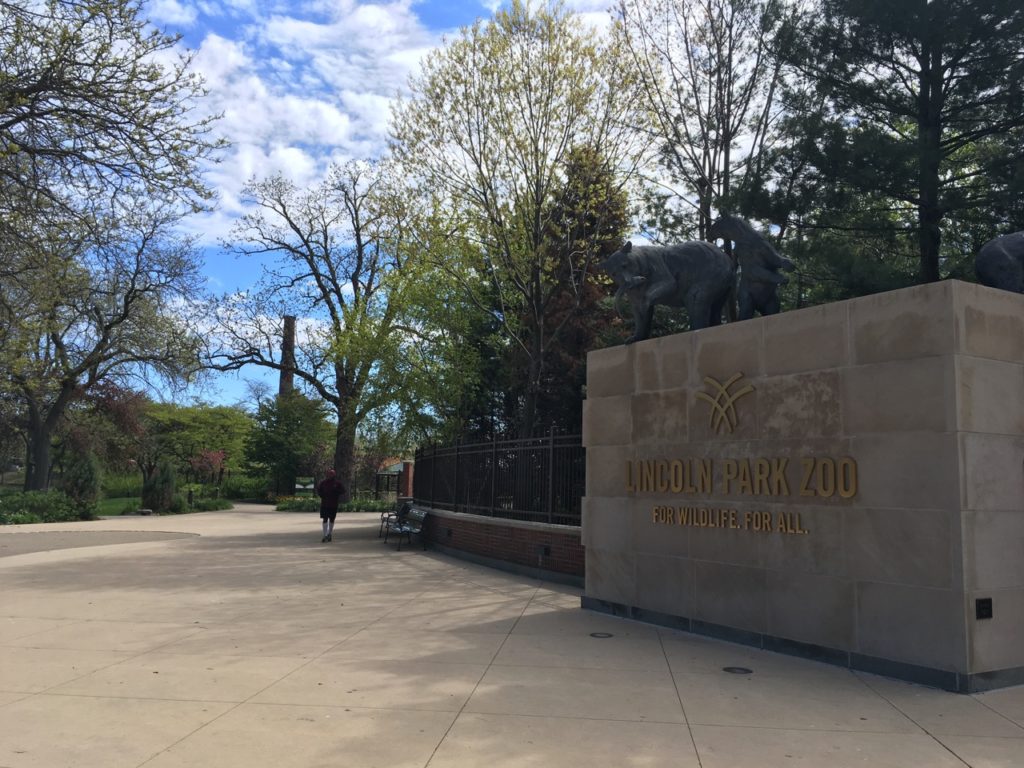
Streeterville and Navy Pier
East of Michigan you’ll find the Streeterville Neighborhood and Navy Pier. Streeterville is mostly residential, and we’re comfortable suggesting you only pass through it if you’re visiting Navy Pier.
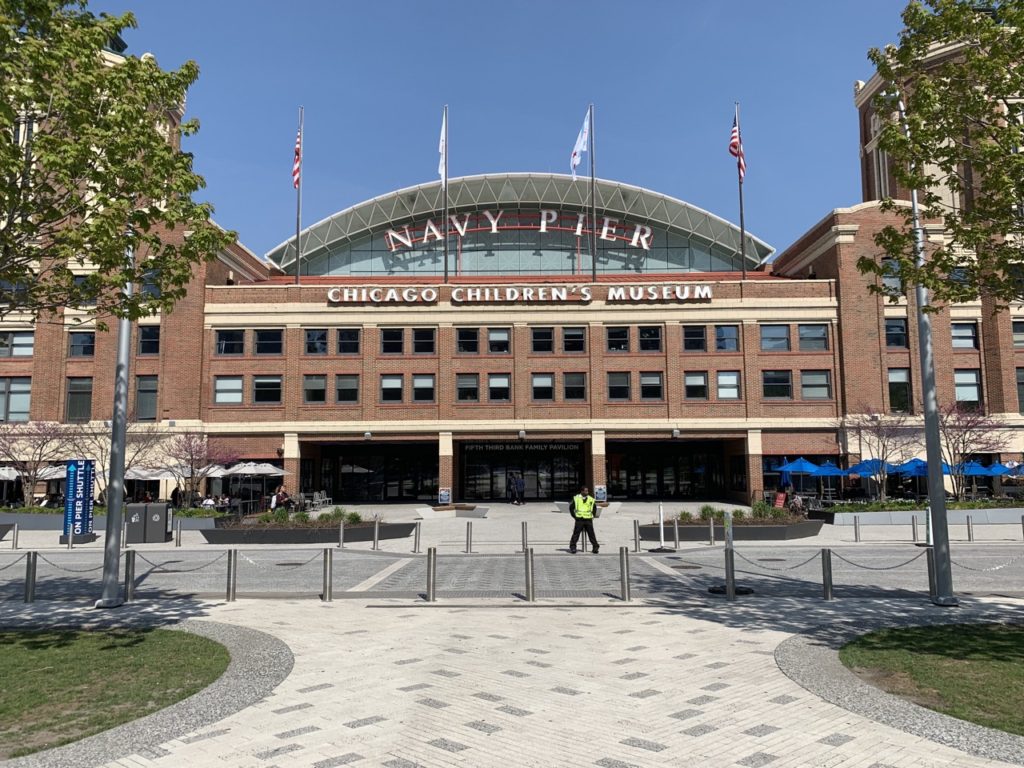
River North
West of Michigan is the River North neighborhood. This is one of the city’s premier dining and nightlife districts.
Chicago Riverwalk
Along the Chicago River (at the south end of the Mag Mile), is the mile-plus Riverwalk, filled with small bars and restaurants and offering some of the best views and people-watching in the city.
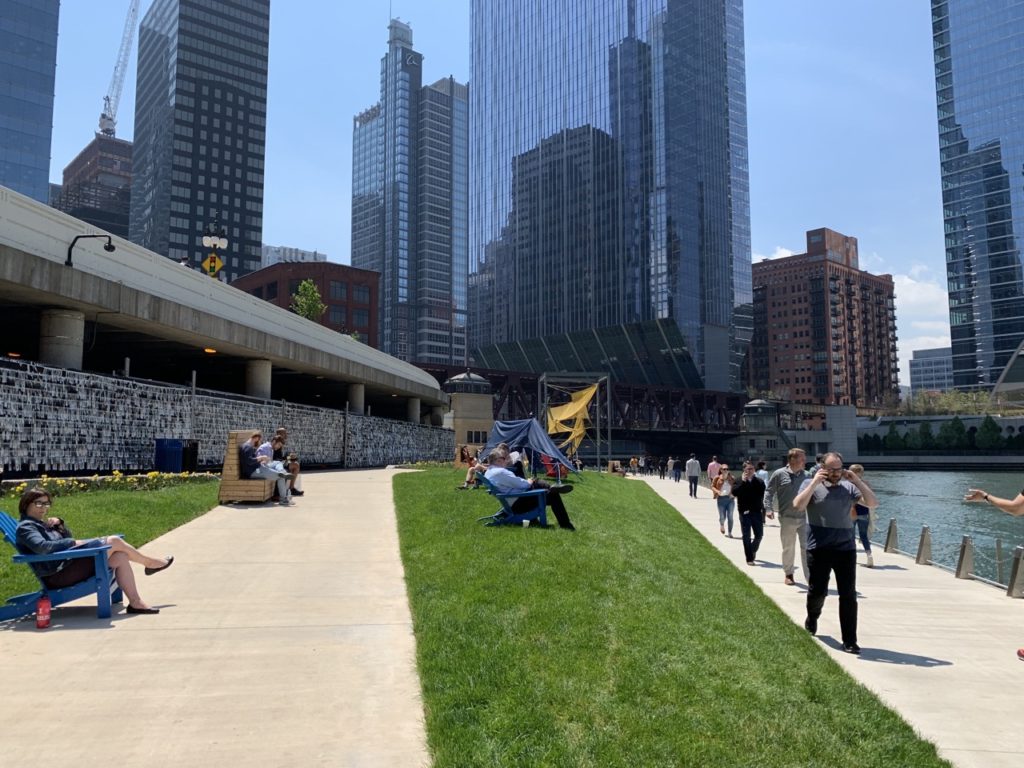
Grant Park and the Loop
Continuing south on Michigan Avenue, you’ll reach the Loop (Chicago’s central business district) and Grant Park. This area includes Millennium Park, Maggie Daley Park, Buckingham Fountain, Willis Tower, the Art Institute, Museum Campus, and many other highlights.
